With one of many world’s highest charges of digital penetration and a younger, mobile-savvy inhabitants, the MENA area (Center East and North Africa) provides a singular digital panorama the place each expertise and cultural alignment drive model engagement.
Nonetheless, MENA nonetheless trails behind international traits in crucial areas—corresponding to working with nano and its ecosystem of specialised influencer advertising companies, stands as one of many largest blockers for a ecosystem that’s absolutely in steadiness, the place provide of varied influencer tiers, may be activated and ran by expert and specialised companies.
Our evaluation identifies vital alternatives for MENA manufacturers to capitalize on rising traits. Whereas international manufacturers more and more favor smaller influencers for prime engagement, cost-efficiency, and authenticity, MENA manufacturers stay closely invested in macro- and mega-influencers, which symbolize 60% of influencer engagements. This reliance on large-scale visibility might miss the nuanced engagement nano- and micro-influencers present in establishing native belief and credibility.
Regardless of these traits, a majority of manufacturers in MENA run solely a restricted variety of influencer campaigns per 12 months, with 61.5% conducting fewer than 5 campaigns and a hanging 71.8% working with fewer than ten influencers per marketing campaign. This method restricts manufacturers’ means to attach with smaller, extremely engaged segments of the viewers—a missed alternative given the excessive engagement nano-influencers ship on a worldwide scale. By specializing in large-scale influencers, MENA manufacturers could also be overlooking the sturdy viewers connections that smaller influencers supply, limiting each authenticity and resonance.
63% of MENA influencers reported a rise in content material centered on social causes—with 35% considerably growing such content material. This shift factors to a rising consciousness of social influence and the significance of brand name alignment with cultural values, an more and more crucial think about influencer collaboration decisions.
Influencer Advertising and marketing Ecosystem in MENA
The MENA influencer advertising ecosystem is uniquely structured and supported by a various set of gamers. In comparison with international markets, MENA remains to be in a developmental section, particularly when it comes to company specialization and accessibility to companies specialised in nano and micro-influencers for instance.
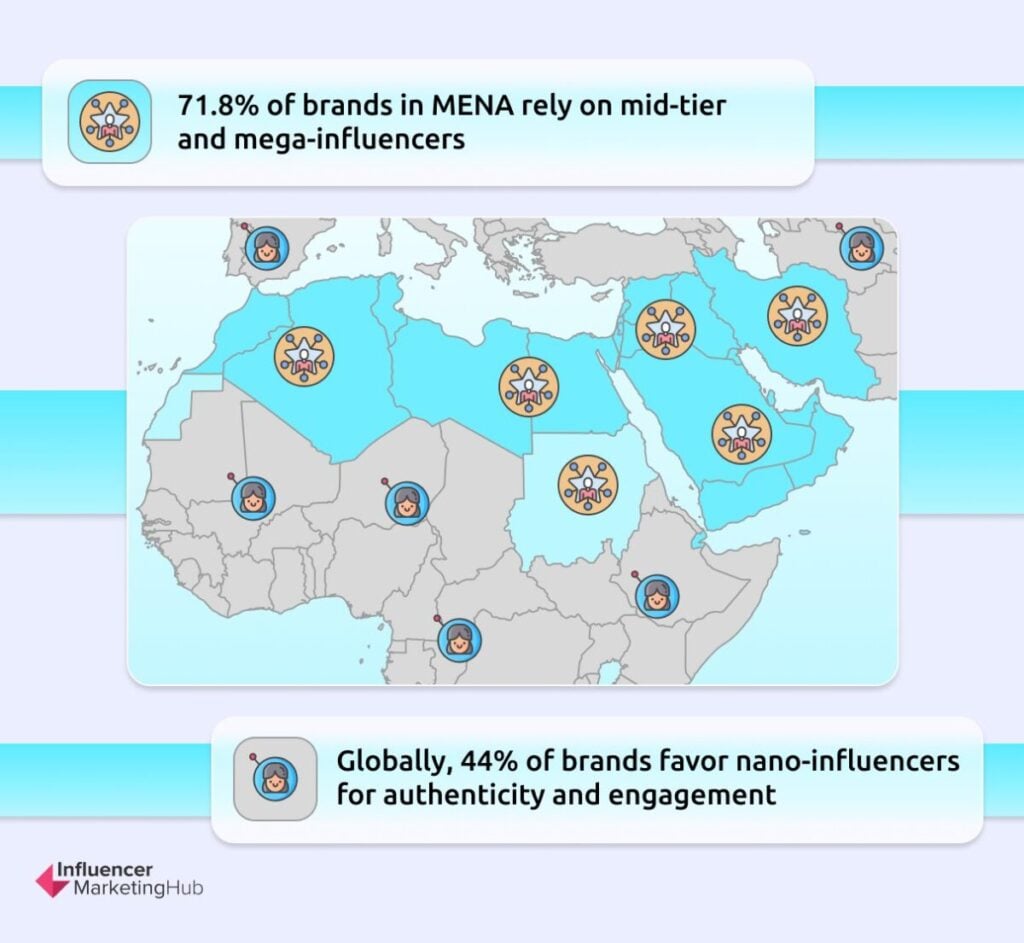
This hole signifies substantial room for progress, with a necessity for a broader and extra subtle infrastructure to execute extremely focused, scalable campaigns. Nations just like the UAE and KSA, with their quickly rising digital landscapes and government-led influencer initiatives, are poised to guide this transformation by increasing the company ecosystem and fostering extra complete assist for manufacturers. The UAE authorities performs a pivotal position within the influencer advertising ecosystem by each fostering progress by means of initiatives just like the AED 150 million fund for content material creators and making certain transparency with licensing laws for influencers. By means of strategic partnerships and regulatory measures, the UAE is positioning itself as a worldwide hub for accountable, revolutionary digital content material creation.
To unlock its full potential, MENA should deal with present limitations, such because the scarcity of specialised companies and software program options and the restricted use of AI and specialised platforms. Increasing company capabilities and adopting superior applied sciences might be key to realizing a extra sturdy, nuanced, and scalable influencer advertising panorama in MENA.
The core layer represents the first stakeholders that instantly drive and form the influencer advertising actions in MENA. These gamers embody:
1. Manufacturers
Manufacturers are on the coronary heart of the influencer advertising ecosystem, setting the targets and aims that form campaigns. In MENA, manufacturers primarily deal with visibility and attain, usually choosing macro and mega influencers to achieve broad publicity. Nonetheless, there’s an rising alternative for manufacturers to discover nano and micro-influencers, which may supply deeper viewers connections and improve model credibility.
Many MENA manufacturers are nonetheless studying to leverage smaller influencers at scale. Restricted company specialization in nano and micro-influencer administration additional complicates their means to implement focused and extremely participating campaigns.
2. Influencers & Creators
Influencers are important in connecting manufacturers with audiences. In MENA, influencers are usually not solely trendsetters but additionally social leaders, as many shoppers view them as trusted sources for life-style inspiration and model suggestions.
The influencer spectrum in MENA closely favors macro and mega influencers, reflecting the area’s cultural values of authority and standing. Nonetheless, influencers throughout all tiers (nano, micro, macro, and mega) have distinct roles to play, and a extra balanced method might convey manufacturers nearer to area of interest audiences.
3. Customers
The youth-driven, mobile-first demographic in MENA is extremely receptive to influencer content material, with over 60% of the inhabitants underneath 30. Customers within the area have a tendency to hunt influencers who mirror their values, tradition, and life-style aspirations.
Gen Z within the Center East and North Africa (MENA) dominates the buyer spending class, with a considerable 23% share—considerably greater than in another area. This generational affect aligns completely with the strengths of influencer advertising, as Gen Z is extremely attentive to social media-driven traits and influencer suggestions, positioning MENA as a first-rate marketplace for manufacturers looking for to faucet into youth-driven consumerism.
Psychographic traits point out that MENA shoppers are more and more interested in influencers who’re socially acutely aware, with 63% of influencers reporting a rise in content material associated to social causes. This shift presents a possibility for manufacturers to align with influencers who prioritize socially accountable messaging.
4. Distribution Channels: Key Social Media Platforms in MENA
Social media platforms, notably TikTok and Instagram, play a vital position in shaping the influencer advertising panorama within the MENA area. Every platform serves totally different viewers preferences, content material codecs, and ranges of engagement, providing manufacturers a spectrum of channels to amplify their advertising efforts.
TikTok has emerged because the dominant platform for nano-influencers (1K–10K followers) within the MENA area, with 11.3 million influencers on this follower vary in comparison with Instagram’s 1.9 million. This huge variety of nano-influencers on TikTok aligns with international traits favoring smaller, extremely engaged creators who drive genuine connections with audiences. Whereas Instagram nonetheless maintains a robust presence, notably at greater follower counts (over 500K), TikTok’s lead within the nano-influencer section positions it as a strong channel for manufacturers seeking to join with grassroots-level audiences at scale.
Nano-Influencers (1K–10K followers): 11.3 million on TikTok vs. 1.9 million on Instagram.
Mid-Tier Influencers (10K–50K followers): TikTok additionally leads with 916K in comparison with Instagram’s 791K.
Excessive-Tier Influencers (500K–1M+ followers): Instagram retains a slight edge in greater follower ranges, making it a most well-liked platform for bigger life-style and luxurious campaigns the place broad visibility is crucial.
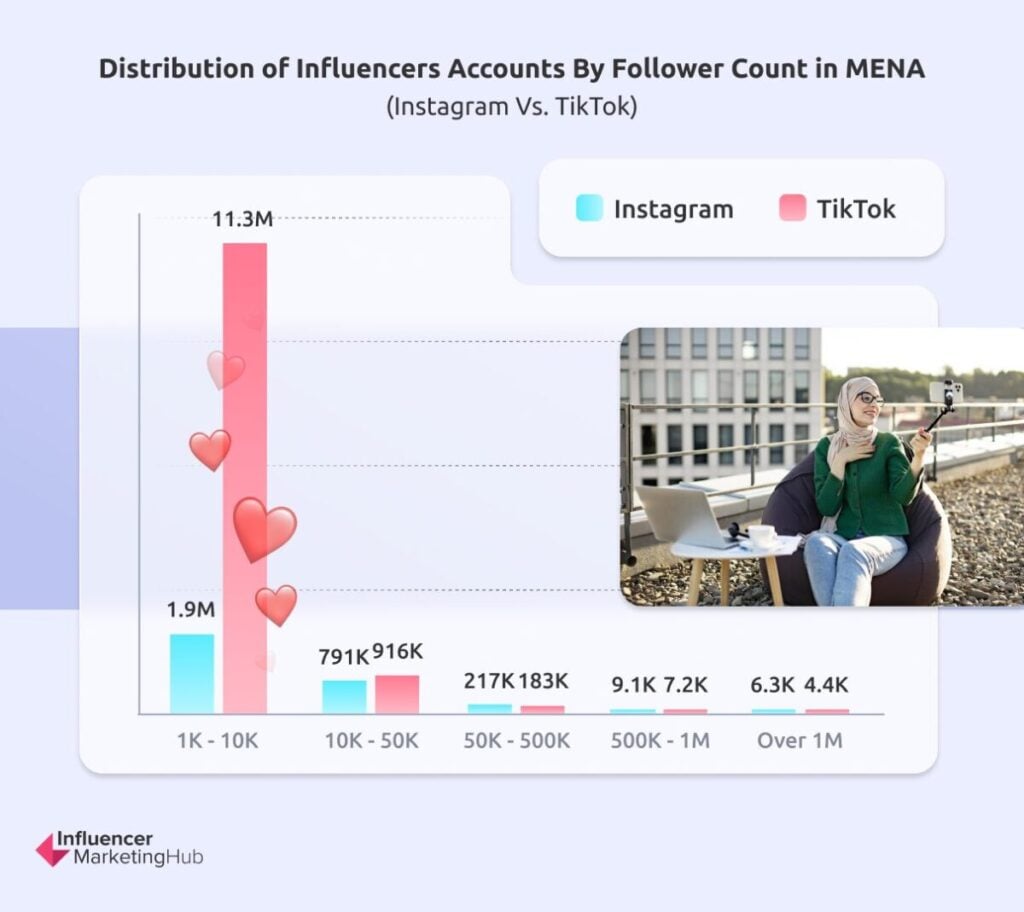

This distribution illustrates the differentiated positioning of every platform in MENA’s influencer ecosystem, with TikTok excelling within the nano-influencer area and Instagram most well-liked for macro-influencer campaigns that demand substantial attain and affect.
TikTok’s dominance extends throughout a number of nations within the area, underscoring its enchantment to youthful demographics who prioritize short-form, visually participating content material. The highest three nations main in influencer numbers on TikTok are:
Saudi Arabia: 2.7 million TikTok influencers vs. 257K on Instagram
Iraq: 2.4 million on TikTok vs. 304K on Instagram
UAE: 1.3 million on TikTok vs. 219K on Instagram
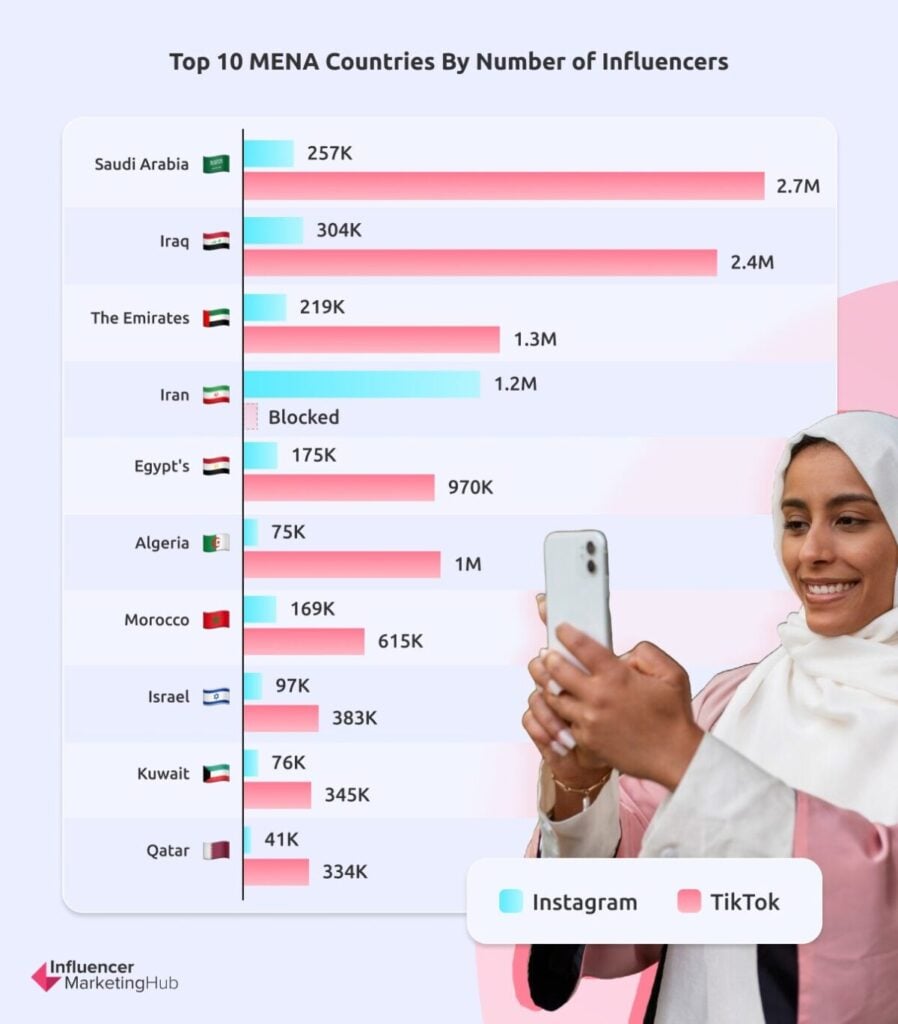

These numbers reveal TikTok’s penetration in MENA, notably in Saudi Arabia, Iraq, and the UAE, the place youthful populations are extremely energetic on the platform. Instagram stays aggressive however has a extra selective following, aligning with its deal with visually pushed industries like style, life-style, and luxurious.
These insights spotlight the distinctive dynamics of every platform inside MENA’s influencer advertising ecosystem. TikTok’s expansive base of nano-influencers provides manufacturers a scalable channel to achieve youthful, extremely engaged audiences, whereas Instagram’s deal with higher-tier influencers continues to enchantment to luxurious and life-style sectors. YouTube enhances these efforts by offering a platform for longer, narrative-driven content material, enabling manufacturers to craft complete digital methods tailor-made to the varied preferences of the MENA client base.
Supporting Layer of the Ecosystem
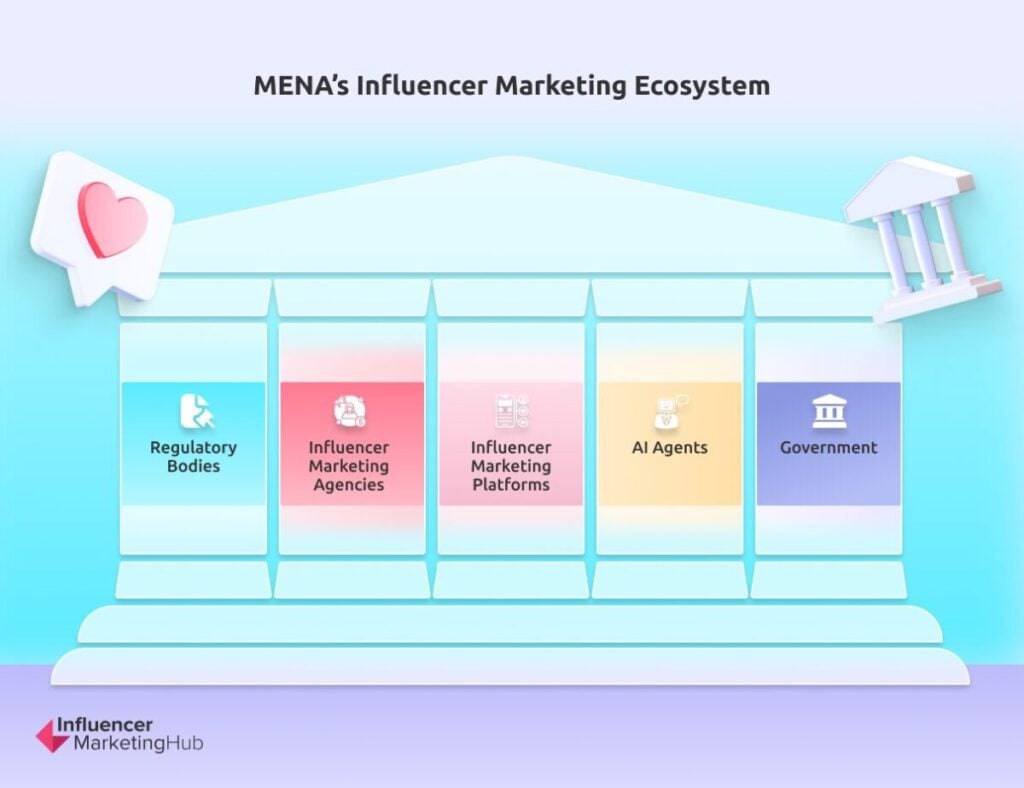

The supporting layer consists of varied entities that allow, regulate, and facilitate influencer advertising operations in MENA. This layer contains:
1. Regulatory Our bodies:
Regulatory our bodies in MENA, notably within the UAE and KSA, impose strict promoting and transparency necessities on influencer advertising. Influencers are required to reveal partnerships and, in some circumstances, get hold of licenses.
This regulatory oversight supplies a layer of authenticity and belief within the influencer ecosystem, making certain that influencers function inside set tips. Nonetheless, it additionally provides complexity, particularly for manufacturers working cross-border campaigns. For instance, influencers within the UAE will need to have a license, with charges for people and companies, which may act as a barrier for smaller influencers coming into the area.
2. Influencer Advertising and marketing Businesses:
Influencer companies play a vital position in bridging the hole between manufacturers and influencers, providing experience in marketing campaign administration, influencer choice, and technique execution.
With 20 influencer advertising companies within the UAE and a lot much less in KSA, MENA remains to be growing its company infrastructure, particularly in comparison with the 300+ companies within the USA.
This shortage of specialised companies limits the power of MENA manufacturers to scale campaigns with nano and micro-influencers, who require extra granular administration. An enlargement of company capabilities might introduce extra superior marketing campaign methods and assist manufacturers entry a wider spectrum of influencers.
3. Influencer Advertising and marketing Platforms:
Platforms designed particularly for influencer advertising streamline the invention, engagement, and administration of influencer partnerships. In MENA, platforms are more and more integrating AI instruments to help in influencer identification, marketing campaign optimization, and efficiency analytics.
Nonetheless, solely 37% of manufacturers in MENA report utilizing AI for influencer discovery, highlighting a possibility to reinforce platform capabilities and adoption. Improved platform functionalities might assist extra customized and scalable campaigns, serving to manufacturers faucet into underutilized influencer segments.
4. AI Brokers (New):
AI brokers symbolize an rising part within the ecosystem, offering superior instruments for knowledge analytics, focusing on, personalization, and even digital influencer creation. In markets just like the UAE, digital influencers have began to seem, aligning with cultural norms whereas providing manufacturers a managed, constant technique of engagement.
Regardless of these improvements, MENA’s AI adoption in influencer advertising trails behind international markets. Increasing using AI brokers can unlock additional alternatives for focused and environment friendly campaigns, permitting manufacturers to scale their influencer methods whereas making certain cultural sensitivity.
5. Authorities:
Nations just like the UAE and KSA are strategically positioned to guide this transformation. Authorities funding, corresponding to Dubai’s AED 150 million fund for content material creators and the UAE’s partnerships with platforms like TikTok to advertise secure digital practices, exemplify a transparent recognition of the influencer {industry}’s potential. These initiatives underscore the UAE’s dedication to establishing a strong influencer ecosystem, setting a robust basis for an expansive, multi-layered {industry}.
The UAE authorities has been proactive in supporting and regulating influencer advertising by means of a number of key initiatives aimed toward nurturing digital content material creation and enhancing on-line security:
Dubai’s AED 150 Million Fund for Influencers and Content material Creators:
Authorities Collaboration with TikTok on Protected Looking Initiatives:
The UAE authorities partnered with TikTok to launch a marketing campaign centered on selling secure on-line practices for youngsters and households. This marketing campaign underscores the UAE’s dedication to fostering a accountable digital panorama, making certain that social media utilization amongst younger customers aligns with security requirements. This initiative not solely encourages secure searching but additionally reinforces belief between influencers, audiences, and types by prioritizing neighborhood well-being.
Influencer Licensing Laws:
Along with monetary assist, the UAE has applied strict licensing necessities for influencers. Influencers who earn cash or obtain items from promotional work on social media are required to acquire a media license, making certain compliance with UAE laws. This regulatory measure promotes transparency and belief throughout the influencer advertising ecosystem and is a step towards formalizing the {industry}.
Supply: Khaleej Instances and cwbip.com
These initiatives collectively reveal the UAE’s dedication to constructing a well-regulated, supportive ecosystem for influencers and content material creators. The federal government’s involvement goals to create a balanced influencer panorama the place innovation and security coexist, setting a excessive commonplace for digital advertising practices throughout the MENA area. By investing in influencers and implementing structured tips, the UAE is reinforcing its place as a number one influencer advertising hub.
Influencer Ecosystem in MENA Evaluation
The MENA influencer advertising ecosystem is at a pivotal stage of progress, mixing speedy digital adoption with distinct regional influences. In contrast to mature markets, MENA nonetheless faces structural gaps, notably in specialised company availability for nano- and micro-influencer campaigns. This underdeveloped infrastructure limits scalability and engagement potential for manufacturers seeking to harness the authenticity and connection that smaller influencers present.
The UAE and Saudi Arabia are spearheading ecosystem enhancements, supported by proactive authorities initiatives. Dubai’s AED 150 million fund for content material creators, coupled with the UAE’s licensing laws and secure searching campaigns with TikTok, displays the federal government’s strategic position as each a regulator and promoter of influencer advertising. These actions set up a managed but supportive surroundings, aiming to place the UAE as a worldwide influencer hub.
To completely unlock MENA’s potential, manufacturers and companies have to advance their capabilities in AI, software program options, and data-driven instruments. By addressing these gaps, MENA can create a strong and scalable ecosystem that leverages influencers throughout all tiers, in the end fostering deeper client connections and market influence.
Development and Market Measurement of Influencer Advertising and marketing in MENA
Influencer Financial system Market Measurement and Projections
The influencer advertising {industry} within the MENA area is on a steep upward trajectory, with spending projected to achieve $576.1 million by 2024, rising at a compound annual progress charge (CAGR) of 9.27% to roughly $897.3 million by 2029. This enlargement is fueled by an more and more digital, youngyouth-driven inhabitants and supported by revolutionary government-led initiatives aimed toward nurturing the digital economic system. The per-user advert spend in MENA’s influencer advertising market is projected to hit $1.23 in 2024, showcasing the deepening penetration of influencer advertising throughout the area’s digital ecosystem.
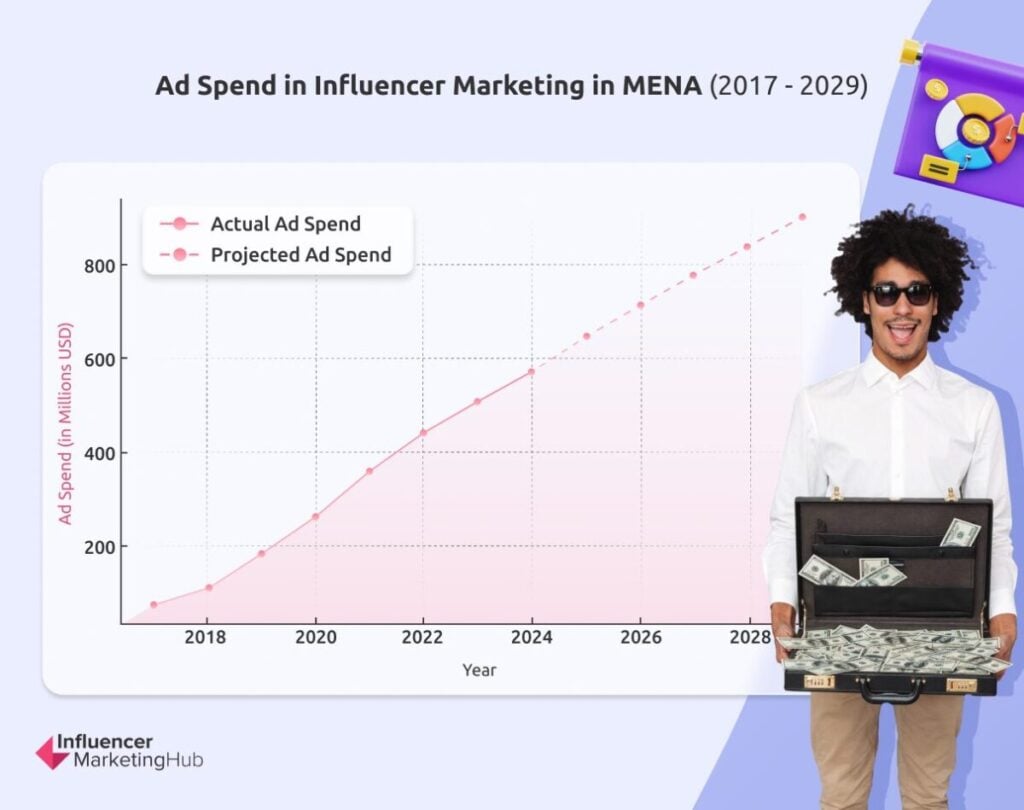

Comparative Evaluation with World Market
Whereas the MENA influencer market’s progress is notable, it’s nonetheless evolving in comparison with extra mature markets like North America and Europe. Globally, manufacturers are progressively shifting in the direction of citizen influencers attributable to their means to foster excessive engagement and genuine client connections. In distinction, MENA stays centered on macro- and mega-influencers, with 60% of influencer advertising spend falling into these classes. This reliance on high-profile influencers displays cultural preferences for standing and authority, but it could restrict the regional market’s scalability and the genuine engagement nano- and micro-influencers herald different areas.
Funding Traits and Spending Habits
Funding in influencer advertising throughout MENA is on the rise, notably in key industries corresponding to magnificence, tech, FMCG, and retail. Within the UAE, for instance, 76.9% of entrepreneurs report that influencer advertising is now a prime precedence, with 46.2% growing their budgets for this technique.
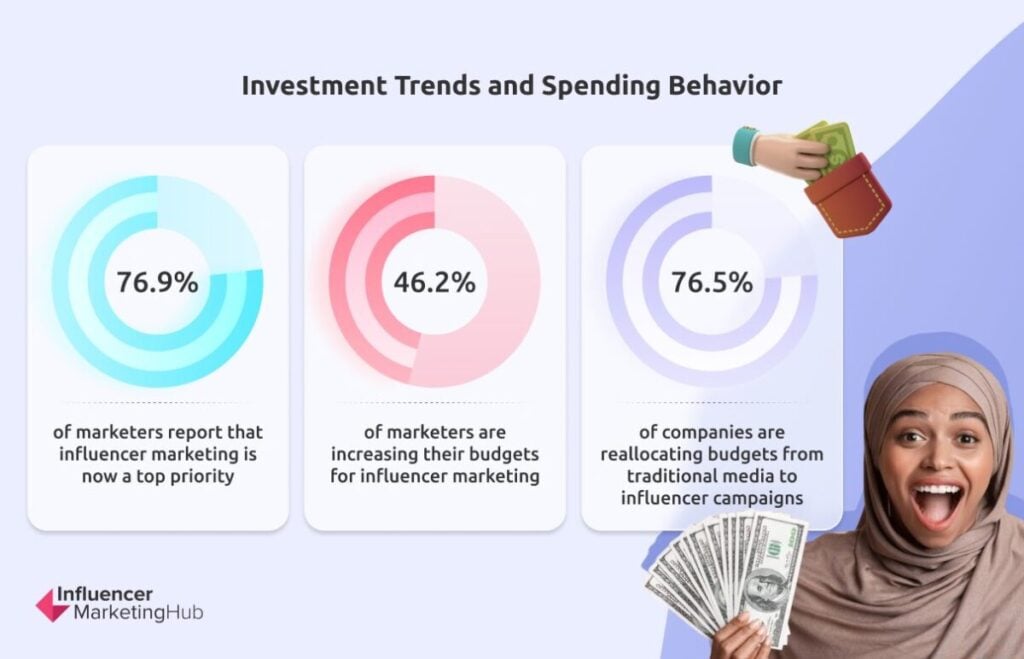

A rising variety of firms (76.5%) are reallocating budgets from conventional media in the direction of influencer campaigns, underscoring a regional shift in the direction of digital-first engagement.
Regardless of this enthusiasm, MENA’s influencer advertising campaigns stay comparatively conservative in scale. A major 61.5% of manufacturers within the UAE conduct fewer than 5 influencer campaigns per 12 months, whereas 71.8% work with fewer than ten influencers per marketing campaign. This restricted scope highlights a serious alternative for manufacturers to broaden their influencer partnerships, particularly by participating nano- and micro-influencers, who supply cost-effective, extremely localized connections with audiences.
Sector-Particular Spending Patterns
Massive firms, notably within the magnificence and luxurious sectors, dominate influencer advertising funding in MENA, usually preferring to work with macro and mega influencers to bolster model visibility and status. However, small and medium-sized enterprises (SMEs) exhibit extra cautious spending behaviors, usually counting on barter offers or restricted engagements.
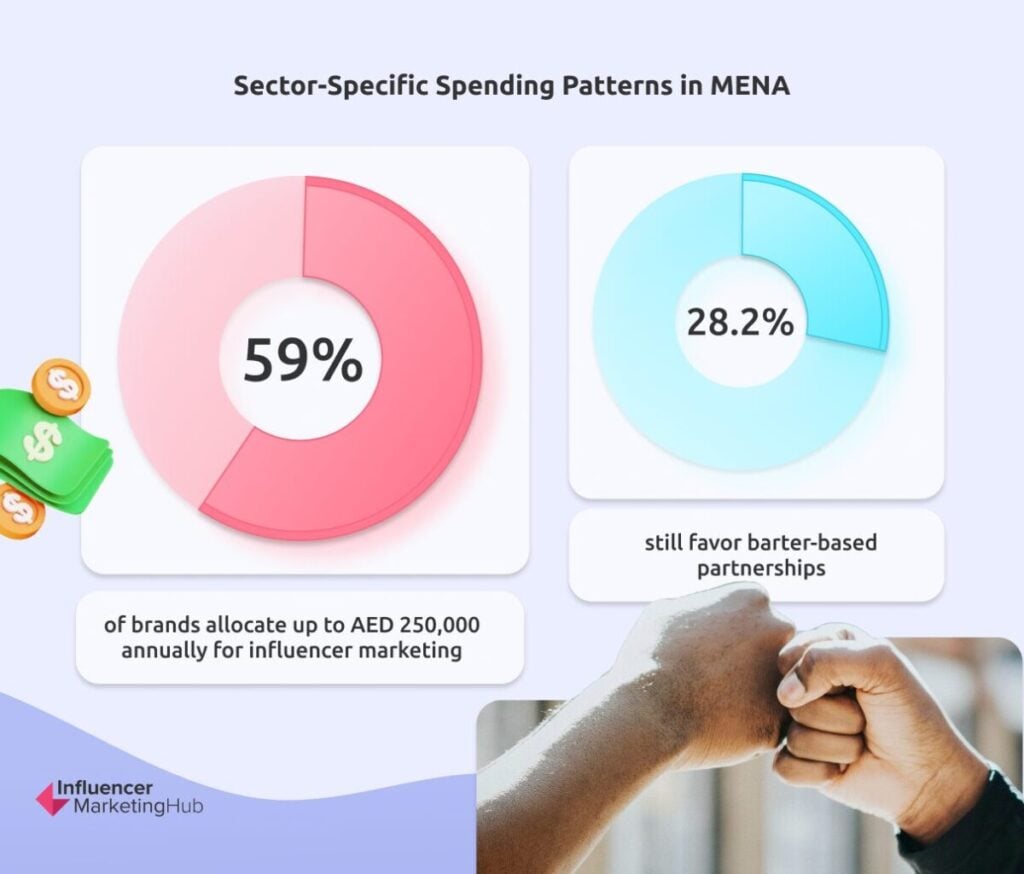

Particularly, within the UAE, 59% of manufacturers allocate as much as AED 250,000 yearly for influencer advertising, with 28.2% nonetheless favoring barter-based partnerships. Nonetheless, as extra subtle ROI measurement instruments turn into accessible, each SMEs and bigger manufacturers are prone to see larger worth in growing their budgets, recognizing influencer advertising as an important pathway to client engagement.
Predictions for Finances Growth
As MENA’s influencer ecosystem continues to mature and adapt to international traits, budgets for influencer advertising are anticipated to broaden, pushed by growing digital adoption and the rise of Gen Z as a strong client class. The strategic deal with social causes amongst influencers—63% of whom report elevated content material round values and points vital to their audiences—will possible drive manufacturers to take a position extra in influencers who embody social accountability and authenticity. This alignment with client values will additional strengthen influencer advertising as a key technique in MENA, positioning the area as a dynamic, culturally nuanced participant within the international digital advertising enviornment.
Key Challenges for Manufacturers and Influencers in MENA
The MENA (Center East and North Africa) area holds immense potential for influencer advertising, with its quickly rising youth inhabitants, digital-savvy viewers, and cultural emphasis on neighborhood and authenticity. Nonetheless, quite a lot of challenges forestall manufacturers and influencers from absolutely realizing this potential. Under are 5 key areas the place obstacles persist, derived from complete analysis into the MENA market.
1. Misalignment in Influencer Tiers and Activation
The MENA area is dwelling to over 13.2 million nano-influencers, but their voices stay largely untapped by manufacturers. Globally, nano and micro-influencers have turn into the spine of influencer advertising, celebrated for his or her authenticity and unparalleled viewers engagement. In distinction, MENA manufacturers proceed to deal with mid-tier and mega-influencers, who, whereas seen, usually lack the relatability and belief that smaller influencers convey. This misalignment highlights a crucial hole between international finest practices and regional methods. With client preferences in MENA more and more leaning towards belief and approachability, the over-reliance on high-profile influencers misses the mark. By failing to activate the potential of nano-influencers, manufacturers are leaving helpful connections on the desk.
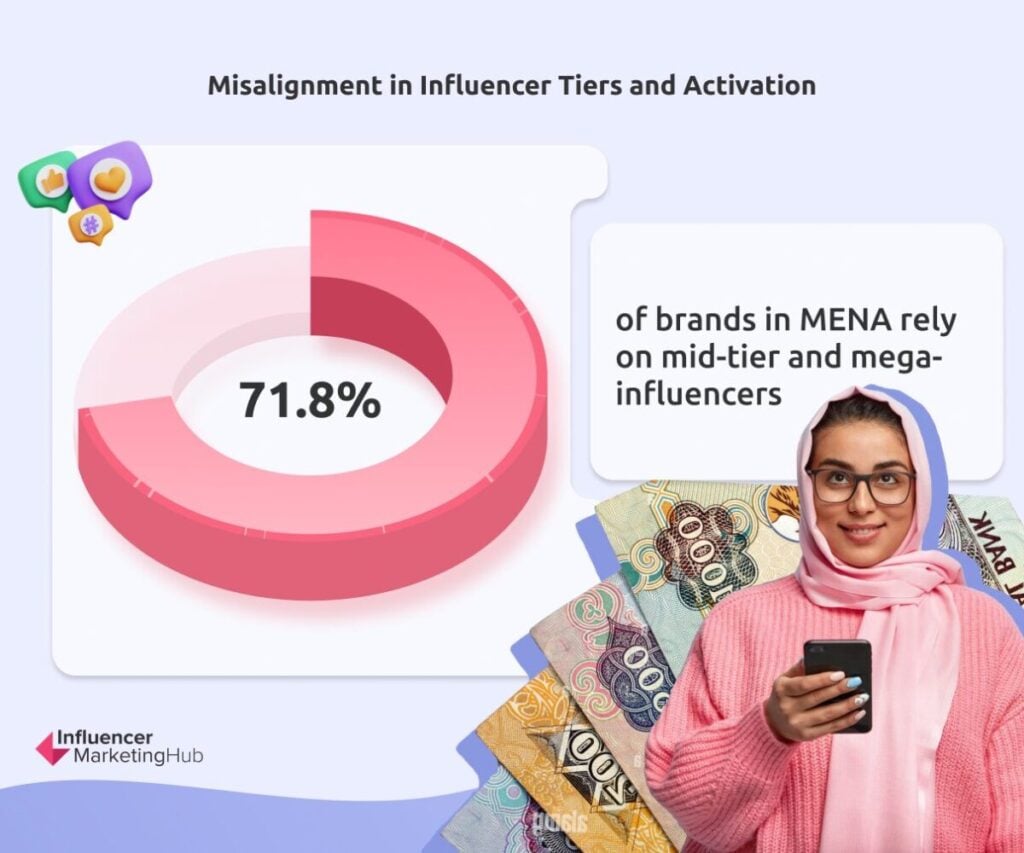

Key Stats:
71.8% of manufacturers in MENA depend on mid-tier and mega-influencers, whereas globally, 44% of manufacturers favor nano-influencers for authenticity and engagement.
MENA has over 13.2 million nano-influencers, however their activation stays disproportionately low.
Evaluation:
Globally, manufacturers are shifting in the direction of nano and micro-influencers for his or her relatability, authenticity, and excessive engagement charges. Nonetheless, in MENA, manufacturers prioritize mid-tier and mega-influencers, usually overlooking the immense belief and resonance that smaller influencers supply. This misalignment restricts marketing campaign effectiveness by lacking alternatives to attach with extremely engaged viewers segments.
Challenges:
Lack of knowledge in regards to the strategic advantages of nano-influencers.
Notion that working with smaller influencers is operationally inefficient in comparison with bigger, extra seen influencers.
Restricted availability of specialised companies to design multi-tiered influencer methods.
Impression:
Manufacturers fail to faucet into the grassroots engagement that nano-influencers can ship, leading to much less relatable campaigns that don’t absolutely capitalize on viewers belief and authenticity.
Recalibrating influencer advertising methods to steadiness nano, micro, and mid-tier influencers for campaigns throughout the buyer funnel.
Educating manufacturers on the cost-efficiency and engagement metrics of nano-influencers by means of localized success tales.
2. Quick-Time period Campaigns and Lack of Lengthy-Time period Partnerships
The story of influencer advertising in MENA is one in all unrealized potential. Whereas international manufacturers have embraced long-term partnerships for his or her means to foster belief and loyalty, MENA manufacturers stay anchored in short-term, campaign-based collaborations. This quick-fix method might obtain quick visibility however lacks the depth wanted for sustained client engagement. In a area the place authenticity and neighborhood resonate deeply with audiences, long-term partnerships can unlock unparalleled alternatives. Influencers want time to attach genuinely with their viewers, whereas manufacturers profit from constant messaging and decreased inventive fatigue. But, over 60% of MENA manufacturers proceed to prioritize one-off engagements, limiting their means to domesticate lasting narratives.
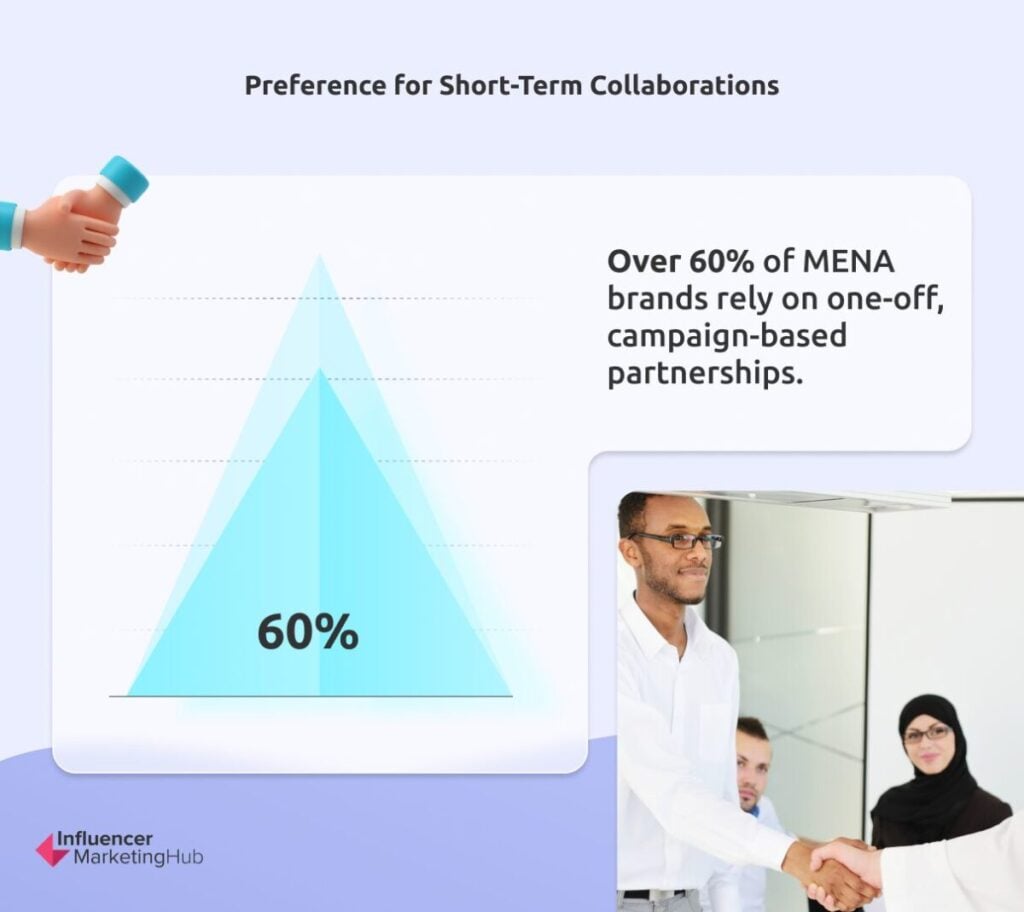

Key Stats:
Over 60% of MENA manufacturers depend on one-off, campaign-based partnerships.
Evaluation:
Quick-term influencer partnerships dominate in MENA, focusing largely on top-of-funnel targets like consciousness. This method limits the power to nurture audiences, construct credibility, and set up constant model narratives. Globally, manufacturers are pivoting towards long-term collaborations to foster belief and drive deeper client engagement.
Challenges:
Emphasis on quick ROI moderately than long-term relationship constructing.
Lack of frameworks for measuring the prolonged influence of influencer campaigns.
Influencers usually lack the chance to construct real, constant narratives for manufacturers attributable to one-off engagements.
Impression:
Quick-term campaigns result in superficial connections with audiences, missed alternatives for advocacy, and inefficient use of influencer potential throughout the buyer funnel.
Encourage manufacturers to spend money on long-term partnerships that permit influencers to develop genuine narratives.
Use AI and analytics to reveal the ROI of sustained influencer collaborations.
Construct metrics for monitoring longer-term impacts, corresponding to natural model mentions and follower sentiment over time.
3. Moral Challenges and Transparency Points
Transparency is the cornerstone of belief in influencer advertising—however in MENA, it’s additionally one in all its most vital challenges. From model stress to keep away from disclosing paid partnerships to influencers’ unfamiliarity with native laws, the moral panorama is riddled with complexities. Over 40% of influencers within the area report stress to compromise transparency, making a belief deficit between manufacturers, influencers, and their audiences. In the meantime, many manufacturers take a hands-off method, inserting the onus of compliance on influencers who might lack the instruments or data to navigate these challenges. The outcome? A rising hole between viewers expectations for authenticity and the {industry}’s present practices.
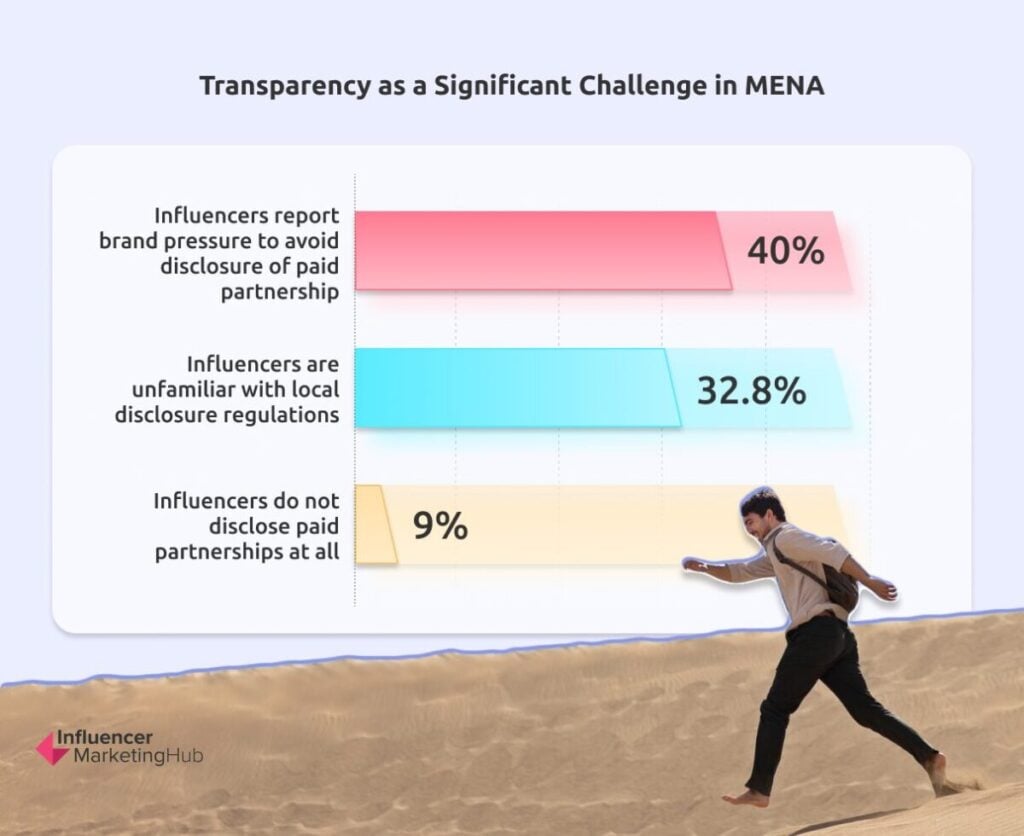

Key Stats:
40% of influencers report model stress to keep away from disclosure of paid partnerships.
32.8% of influencers are unfamiliar with native disclosure laws, and 9% don’t disclose paid partnerships in any respect.
Evaluation:
Moral transparency is a rising concern in MENA. Whereas manufacturers usually push influencers to sidestep disclosure necessities, influencers themselves might really feel that transparency compromises engagement and authenticity. This creates a belief deficit, undermining each influencer and model credibility.
Challenges:
Insufficient enforcement of native promoting and disclosure laws.
Excessive prices related to licensing necessities for influencers, notably nano and micro-influencers.
Perceived trade-off between transparency and authenticity.
Impression:
The dearth of transparency erodes viewers belief, making it more durable for manufacturers to construct long-term loyalty. Moreover, the inconsistent software of disclosure laws creates reputational dangers for each influencers and types.
Develop industry-wide requirements and sources for disclosure compliance.
Implement technology-driven options, corresponding to AI-powered monitoring instruments, to make sure adherence to moral tips.
Present influencers with incentives and instruments to reveal partnerships transparently with out concern of shedding engagement.
4. Restricted Marketing campaign Variety and Multi-Channel Methods
In a world the place shoppers traverse a number of platforms and touchpoints, MENA manufacturers usually stay confined to single-platform campaigns and top-of-funnel targets. This slender focus overlooks the huge alternatives supplied by full-funnel, multi-channel methods that information audiences from consciousness to conversion. With platforms like TikTok and Instagram providing distinct strengths, the shortage of integration throughout channels restricts manufacturers’ means to interact audiences holistically. Including to this problem is the restricted technical experience wanted to execute multi-platform campaigns successfully. Because of this, the area’s campaigns usually fail to capitalize on the fragmented however interconnected client journey.
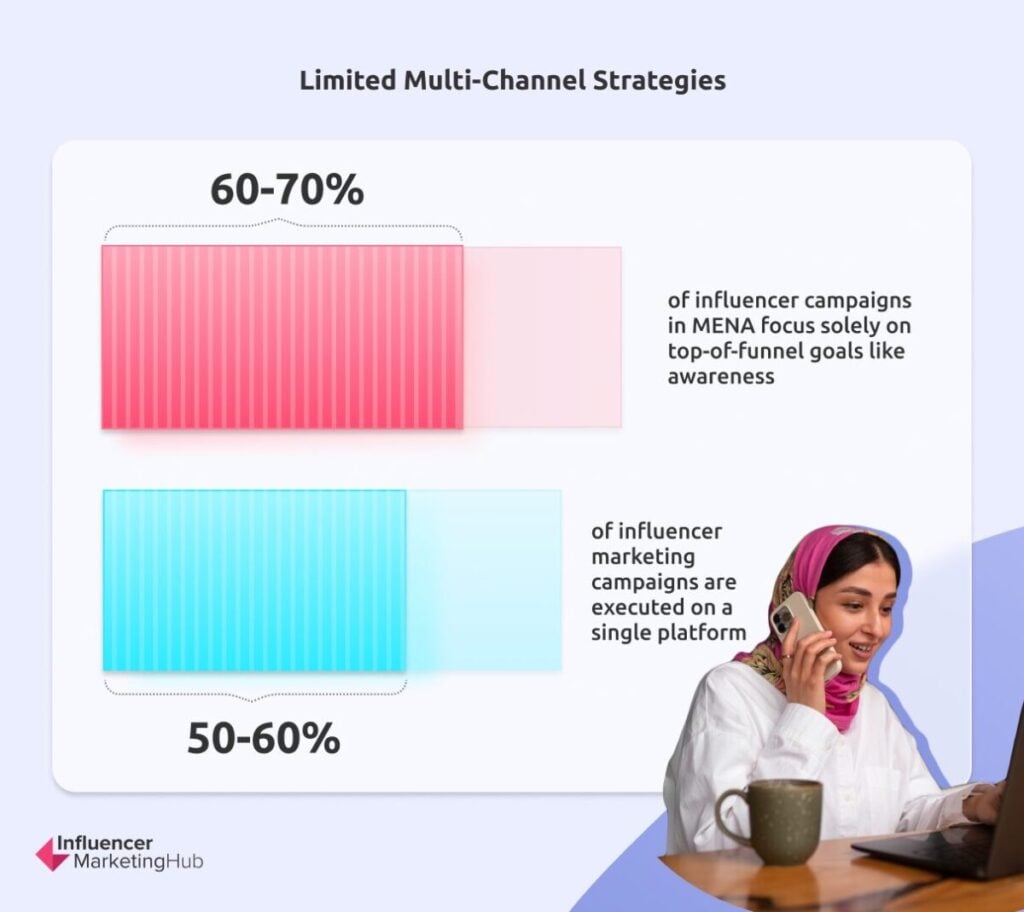

Key Stats:
60-70% of influencer campaigns in MENA focus solely on top-of-funnel targets like consciousness.
50-60% of campaigns are executed on a single platform, regardless of the area’s numerous social media panorama.
Evaluation:
Many MENA campaigns are overly centered on single-funnel and single-platform methods. This slender method neglects the chance to information shoppers by means of the whole purchaser journey, from consciousness to buy. Moreover, platforms like TikTok and Instagram supply distinctive strengths which can be underutilized when campaigns stay confined to 1 platform.
Challenges:
Manufacturers lack the technical experience to execute full-funnel, multi-channel campaigns.
Overreliance on established platforms like Instagram whereas underestimating the expansion potential of TikTok and YouTube within the area.
Restricted use of AI and analytics to optimize cross-platform methods.
Impression:
This single-platform focus restricts viewers attain, engagement, and conversion potential. It additionally hampers manufacturers’ means to adapt to client conduct throughout totally different phases of the funnel.
Prepare manufacturers to implement full-funnel methods that combine consciousness, consideration, and conversion targets.
Use AI to handle and scale multi-channel campaigns, notably with micro and nano-influencers.
Spotlight case research that showcase the success of multi-channel methods in driving client engagement and ROI.
5. Ecosystem Gaps and Lack of Specialised Businesses
The MENA area’s influencer advertising ecosystem is at a pivotal crossroads. Whereas it boasts a wealth of gifted influencers throughout tiers, the infrastructure to assist them remains to be catching up. With solely a handful of specialised companies working within the area, manufacturers usually wrestle to design campaigns that steadiness authenticity, attain, and engagement. The absence of area of interest experience—commonplace in mature markets just like the U.S.—limits the area’s means to activate influencers successfully, particularly nano and micro-influencers. Moreover, operational challenges like excessive licensing prices and insufficient marketing campaign administration instruments exacerbate inefficiencies.
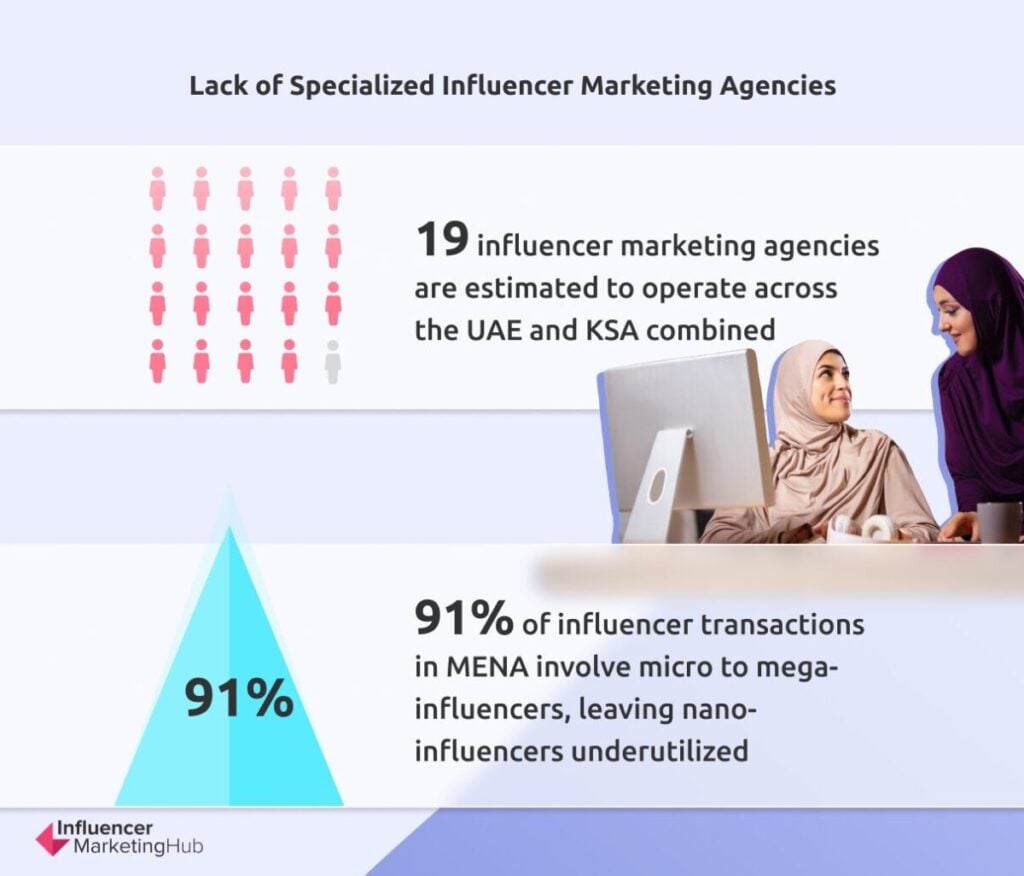

Key Stats:
Solely 19 influencer advertising companies are estimated to function throughout the UAE and KSA mixed.
91% of influencer transactions in MENA contain micro to mega-influencers, leaving nano-influencers underutilized.
Evaluation:
The influencer advertising ecosystem in MENA lacks the specialization and infrastructure seen in mature markets just like the U.S. and Europe. Most companies within the area function as generalists, limiting their means to deal with the distinctive dynamics of nano, micro, and mid-tier influencer activation. This creates a crucial hole in absolutely balancing the provision and demand of influencers.
Challenges:
Restricted variety of specialised companies able to executing multi-tiered, psychographics-driven campaigns.
Excessive operational prices for manufacturers attempting to activate nano and micro-influencers at scale.
Lack of training and sources for influencers to navigate licensing, compliance, and marketing campaign administration.
Impression:
The underdevelopment of the ecosystem prevents MENA from unlocking the complete potential of its influencer base, leaving nano-influencers notably underutilized. This additionally hinders manufacturers’ means to execute localized, culturally related campaigns.
Encourage worldwide companies with specialised experience to ascertain operations in MENA.
Promote partnerships between native manufacturers and area of interest companies to deal with ecosystem gaps.
Put money into training and infrastructure to assist nano and micro-influencer activation, together with sponsored licensing choices.
Whereas the MENA area provides immense potential for influencer advertising, key challenges in tier activation, transparency, marketing campaign methods, and ecosystem improvement proceed to carry again progress. By addressing these points with focused options—corresponding to investing in long-term partnerships, fostering ecosystem specialization, and leveraging AI—manufacturers and influencers in MENA can unlock new alternatives for progress, belief, and viewers engagement. The way forward for influencer advertising in MENA is ripe for innovation; the query is, who will rise to the problem?
Influencer Advertising and marketing Traits in MENA
As influencer advertising in MENA grows quickly, manufacturers face each alternatives and challenges in retaining tempo with international developments. Whereas the area has made strides, particularly in social accountability and cultural alignment, there’s a clear hole in AI adoption and predictive analytics. MENA manufacturers might unlock vital benefits by embracing AI-driven instruments for exact influencer matching, marketing campaign optimization, and emotion-driven insights to create customized, impactful content material.
Moreover, with client behaviors shifting towards social search on platforms like TikTok and YouTube, manufacturers ought to undertake Search engine marketing-style methods tailor-made to social algorithms to seize consideration at each stage of the client journey. By addressing these areas, MENA can transfer nearer to realizing its full potential within the influencer advertising enviornment, changing into each a culturally resonant and digitally superior market.
1. Incorporating Social Duty and Moral Requirements as Key Elements
MENA shoppers, particularly youthful demographics, prioritize manufacturers that align with their values and contribute positively to society. Within the final 12 months alone, 63% of influencers in MENA elevated their deal with social causes, with 35% exhibiting vital rises in content material on points corresponding to environmental sustainability and social justice. This shift demonstrates a requirement for manufacturers that showcase moral stances, with influencers selecting partnerships based mostly on these values. For manufacturers, the chance is evident: partnering with influencers who resonate with moral, social, or environmental causes can improve model credibility and drive stronger, value-based engagement.
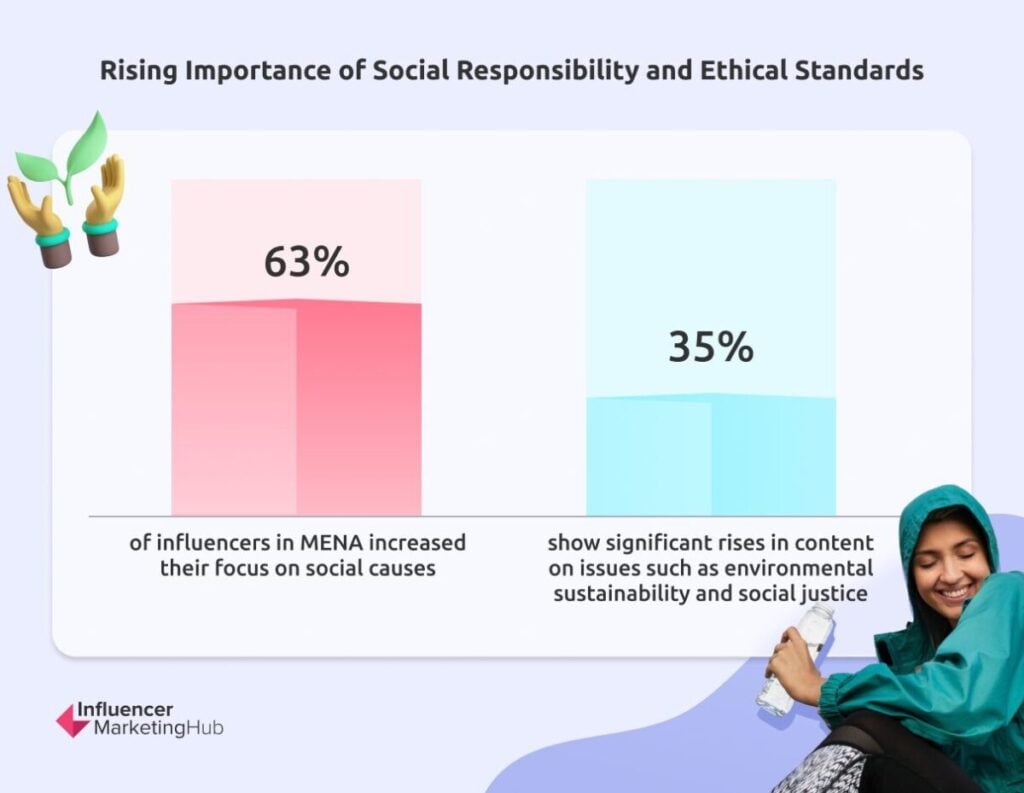

Case Examine:
In the course of the 2023–2024 interval, campaigns that addressed social or moral points, corresponding to Ramadan charity initiatives, carried out exceptionally effectively. These campaigns fostered a way of communal accountability and helped manufacturers join deeply with audiences on culturally vital ranges. The alignment with such values amplifies emotional resonance, making influencer collaborations extra than simply advertising—moderately, they turn into actions that encourage real client motion.
Key insights
Model-led Ramadan advertising exercise is approaching saturation level in Dubai, prompting manufacturers to deploy each new and outdated methods throughout a number of Gulf cities.
An more and more localized method to Ramadan campaigns, collections and occasions has inspired manufacturers to check out different codecs and venues.
Regardless of heightened exercise, most manufacturers have opted for a ‘quieter’ tone to keep away from overly ostentatious or frivolous activations because of the humanitarian disaster in Gaza.


Supply: businessoffashion.com
Ramadan presents a singular alternative for manufacturers in MENA to align with values corresponding to charity, neighborhood, and environmental accountability, which resonate deeply with regional shoppers. Campaigns throughout this era emphasize social good, reflecting a shift in client expectations for manufacturers to not solely promote but additionally contribute positively to society.
Instance Tactic: Addressing Meals Waste
Pizza2Go’s ¾ Pizza Marketing campaign: In partnership with Emirates Crimson Crescent, Pizza2Go created a marketing campaign providing a ¾ pizza field to cut back meals waste throughout Ramadan. Provided that Iftar (the meal breaking the quick) usually includes surplus meals, this marketing campaign instantly tackled the difficulty by encouraging shoppers to order smaller parts.
Impression: This marketing campaign did not simply increase consciousness about meals waste; it additionally donated 25% of gross sales to charity, making a twin influence of client engagement and social accountability. This aligns with the broader Ramadan values of generosity and modesty, making the model not only a vendor however a accountable member of the neighborhood.
Instance Tactic: Empowering Sustainability
Outdated El Paso’s #WrapItUp Marketing campaign: Partnering with TikTok influencers, Outdated El Paso inspired customers to “wrap up” their leftovers into Mexican-style meals. Every generated recipe led to a donation to the UAE meals financial institution, seamlessly combining sustainability, neighborhood involvement, and leisure.
Impression: By utilizing TikTok, Outdated El Paso reached a youthful, mobile-first viewers and fostered a community-driven method to meals waste. This tactic positioned the model as environmentally acutely aware whereas leveraging influencer attain to amplify the message successfully.
Charitable initiatives are pivotal throughout Ramadan, aligning with the month’s values of generosity and serving to others. Manufacturers that lead with charity see greater engagement and optimistic model notion, as shoppers view them as companions in significant causes.
Instance Tactic: Supporting Group Causes
Meta’s #MealsForReels Marketing campaign: Meta’s Ramadan marketing campaign supported the 1 Billion Meals initiative, encouraging consumer participation by sharing meal-focused Reels on Instagram, with every shared video contributing to a meal donation.
Impression: This marketing campaign leveraged the platform’s engagement options to amplify attain and inspired consumer participation for a social trigger, linking digital exercise to tangible influence. The alignment with a well known charity initiative fostered credibility and positioned Meta as a model that makes use of its affect to assist optimistic change.
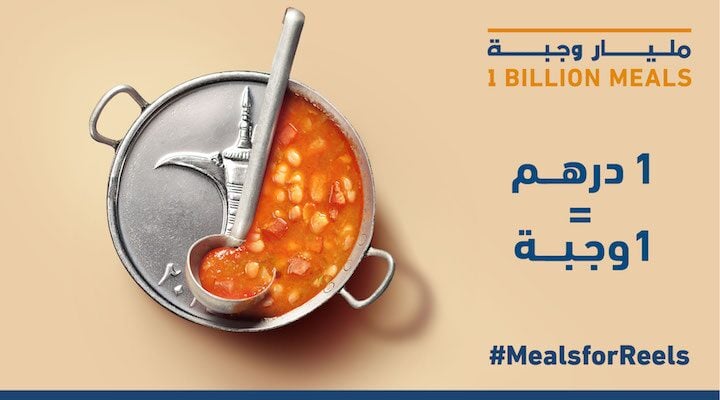

2. Predictive Analytics for Future Influencer Advertising and marketing Traits
Predictive analytics is gaining traction within the MENA area, although its adoption (37%) nonetheless lags behind the worldwide common (63%). Manufacturers that leverage predictive analytics can forecast marketing campaign outcomes, optimize sources, and tailor content material extra precisely to viewers preferences. By analyzing historic knowledge, MENA manufacturers can predict top-performing content material sorts, influencer matches, and even potential attain and engagement metrics.
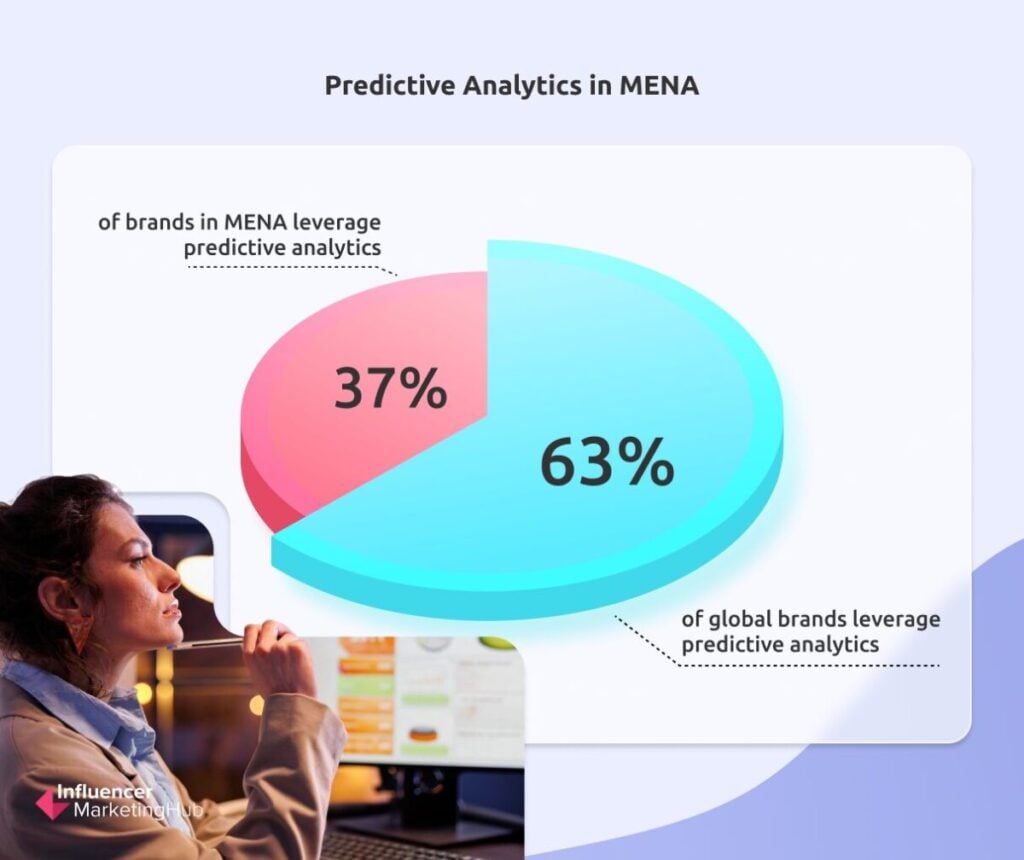

As an illustration, insights from prior campaigns might reveal that video-based content material on platforms like TikTok engages Gen Z audiences considerably greater than static posts. With this information, manufacturers can proactively design future campaigns to emphasise high-performing codecs, optimizing each attain and ROI. This development might shut the hole between MENA and different areas, enabling manufacturers to make use of data-driven insights for strategic benefits.
3. Lengthy-Time period Partnerships to Improve Authenticity
One-off influencer collaborations are waning as manufacturers acknowledge the necessity for extra constant, genuine messaging. Lengthy-term partnerships create stronger emotional connections, as seen in iconic model partnerships like Nike with Michael Jordan and Pepsi with Messi. Within the MENA area, shoppers worth influencers who genuinely interact with manufacturers over time, making them seem as real model ambassadors moderately than paid endorsers.
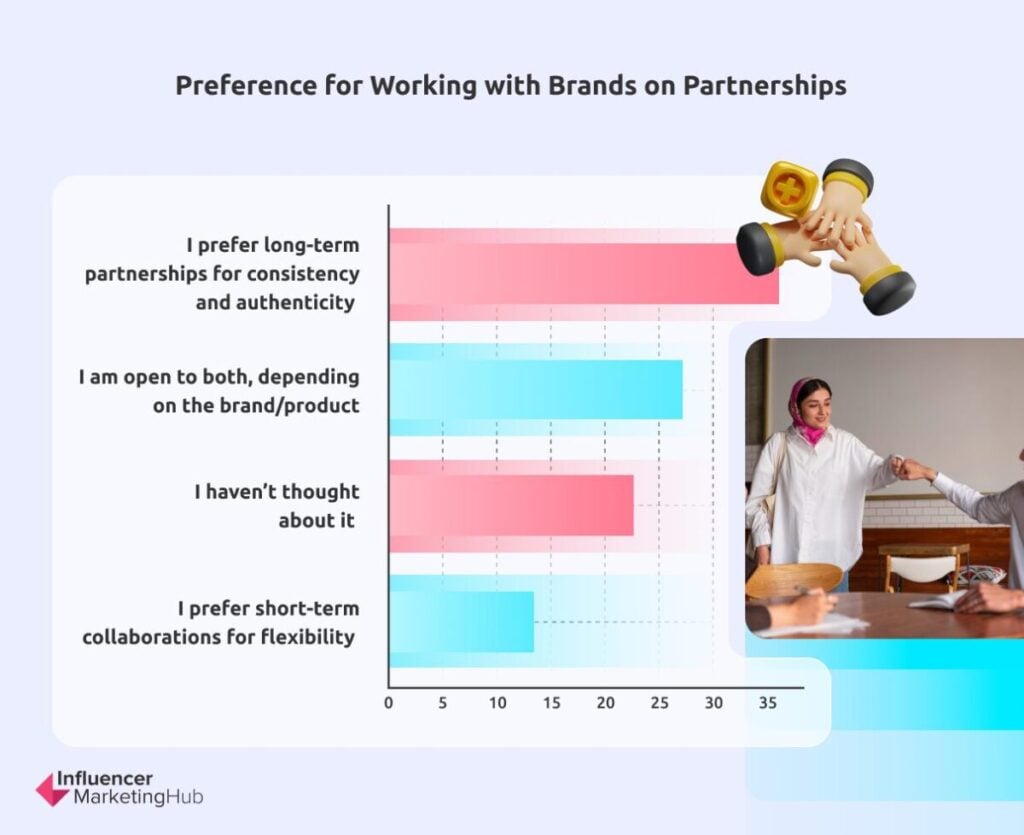

Impression of Lengthy-Time period Partnerships: When influencers often endorse manufacturers, it builds belief amongst their followers, resulting in greater engagement and loyalty. In a area that also closely depends on macro and mega influencers, the shift to sustained collaborations with nano and micro-influencers can supply a steadiness of attain and authenticity, tapping into smaller circles of affect with greater ranges of engagement and belief.
4. Rise of Social Search as a Shopper Habits Shift
MENA shoppers more and more use social media platforms as serps for suggestions, opinions, and tutorials. TikTok dominates journey suggestions, whereas YouTube is the go-to for product opinions, remodeling these platforms into crucial search instruments. For manufacturers, this shift requires a content material technique that mirrors Search engine marketing however tailor-made to social algorithms—specializing in engagement metrics like video completion charges, session period, and viewer interplay. Roughly 31% of shoppers now use social media to seek out solutions to their questions, with 15% preferring social media over serps for his or her inquiries. Amongst Gen Z and Millennials, this choice rises to 29%, indicating a notable development in the direction of social search as a main info supply.
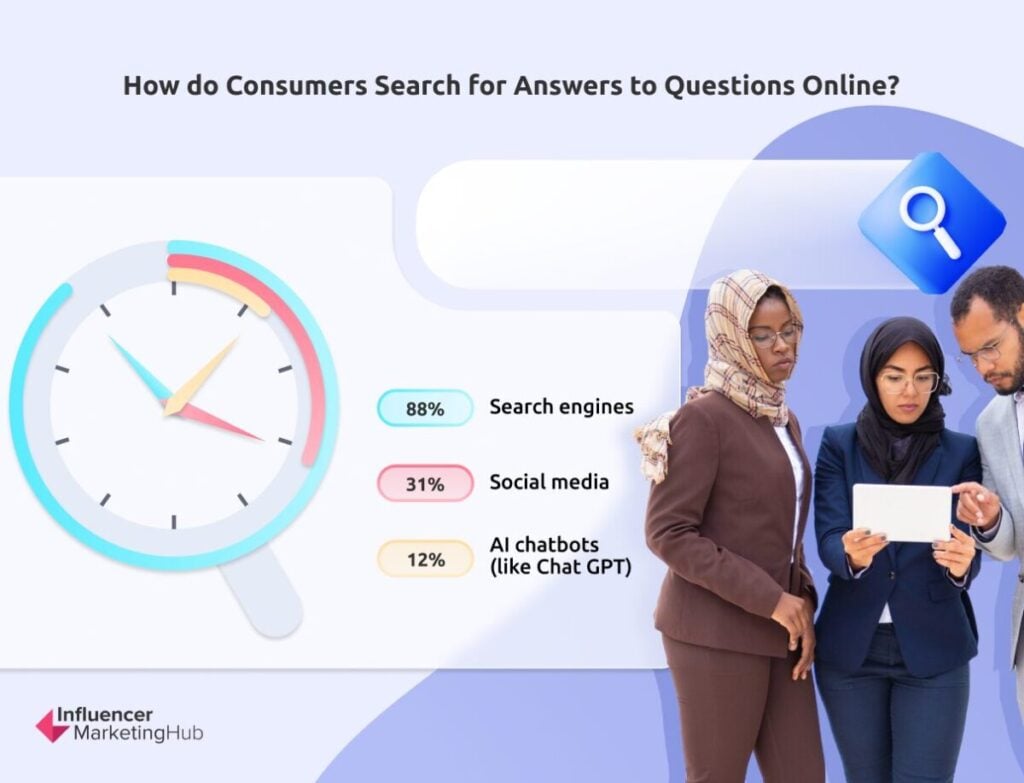

Key Technique: Creating searchable, high-value content material on TikTok and YouTube permits manufacturers to seize viewers consideration at a number of phases of the client journey, from discovery to consideration. By optimizing content material for social search, MENA manufacturers can improve visibility and turn into trusted sources of their area of interest, addressing the rising client development of “social Search engine marketing.”
5. AI Expertise Driving Influencer Advertising and marketing: Digital Influencers and Analytics
AI is revolutionizing influencer advertising, although MENA nonetheless trails in adoption. Digital influencers like Lil Miquela or Shudu Gram have confirmed to be cost-effective and constant, enabling manufacturers to provide hyperlocal content material with out logistical constraints. In areas just like the UAE, AI-driven digital influencers might supply manufacturers cultural alignment and consistency, tapping into area of interest markets with minimal useful resource calls for.
For Businesses and Manufacturers: AI-powered instruments are streamlining outreach, influencer identification, content material analytics, and even predicting marketing campaign success by means of Emotion AI, corresponding to Affectiva’s expertise, which gauges viewer feelings based mostly on facial expressions. Manufacturers using AI-driven analytics can extra precisely match influencers, optimize content material for engagement, and gauge viewer emotional responses earlier than marketing campaign launches. This innovation has the potential to refine brand-influencer relationships and increase marketing campaign ROI considerably.
6. Full-Funnel, Multi-Platform Methods to Maximize Attain and Conversions
MENA’s main influencer advertising companies are more and more embracing full-funnel, multi-platform approaches that concentrate on shoppers throughout touchpoints. This tactic maximizes attain and leverages every platform’s strengths for various phases of the client journey. For instance, companies like Ubiquitous have proven success by aligning top-of-funnel actions on TikTok and Instagram for model consciousness whereas using YouTube for bottom-of-funnel conversion, notably for high-ticket gadgets that profit from detailed opinions.
Case Examine – Ubiquitous and Litter-Robotic: Ubiquitous used a multi-platform marketing campaign to drive engagement and conversion for Litter-Robotic, a high-ticket merchandise. With YouTube supporting in-depth product opinions for high-intent consumers, and Instagram and TikTok driving consciousness, Ubiquitous exemplifies the effectiveness of a full-funnel method. This technique aligns with MENA’s potential to leverage platform-specific strengths to information shoppers seamlessly from discovery to buy.
7. Citizen Influencers: Partaking On a regular basis Customers for Genuine Affect
A brand new layer of influencers, dubbed “Citizen Influencers,” is rising globally and gaining traction in MENA. This development democratizes affect by empowering on a regular basis shoppers to turn into influencers by means of platforms like Social Tip, rewarding customers based mostly on engagement. In a area the place 28.2% of manufacturers nonetheless use barter-based partnerships, citizen influencers supply manufacturers an genuine, cost-effective strategy to attain engaged audiences at scale.
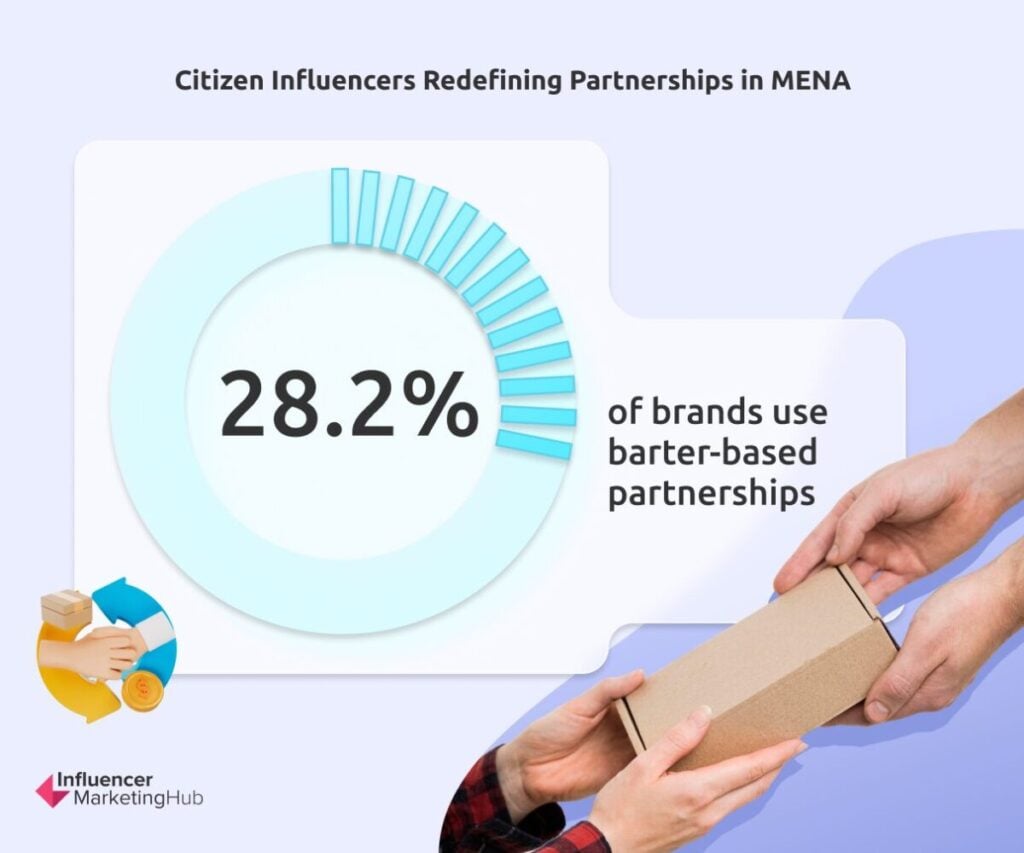

Instance: James Watt, founding father of BrewDog, advocates for this grassroots method, permitting manufacturers to interact actual shoppers as advocates. Citizen influencers drive authenticity and amplify model messages at a neighborhood stage, bridging the hole between nano influencers and conventional model endorsements. MENA manufacturers might faucet into this development to broaden their attain with out the excessive prices of conventional influencer advertising.
7. Social Commerce – This 12 months, it is lastly taking place
In 2025, social commerce is about to turn into a transformative power within the retail panorama, evolving from a long-promised development right into a tangible actuality. For years, the potential for social commerce was clear, but the market did not absolutely materialize. What’s totally different now’s the appearance of closed-loop ecosystems on platforms like Fb and Instagram, the place the whole procuring journey—from discovery to buy to returns—happens with out customers needing to go away the platform, as illustrated within the picture. This shift not solely improves consumer expertise but additionally supplies platforms with crucial client knowledge that fuels additional personalization and focusing on, in the end enhancing buy intention and conversion charges.
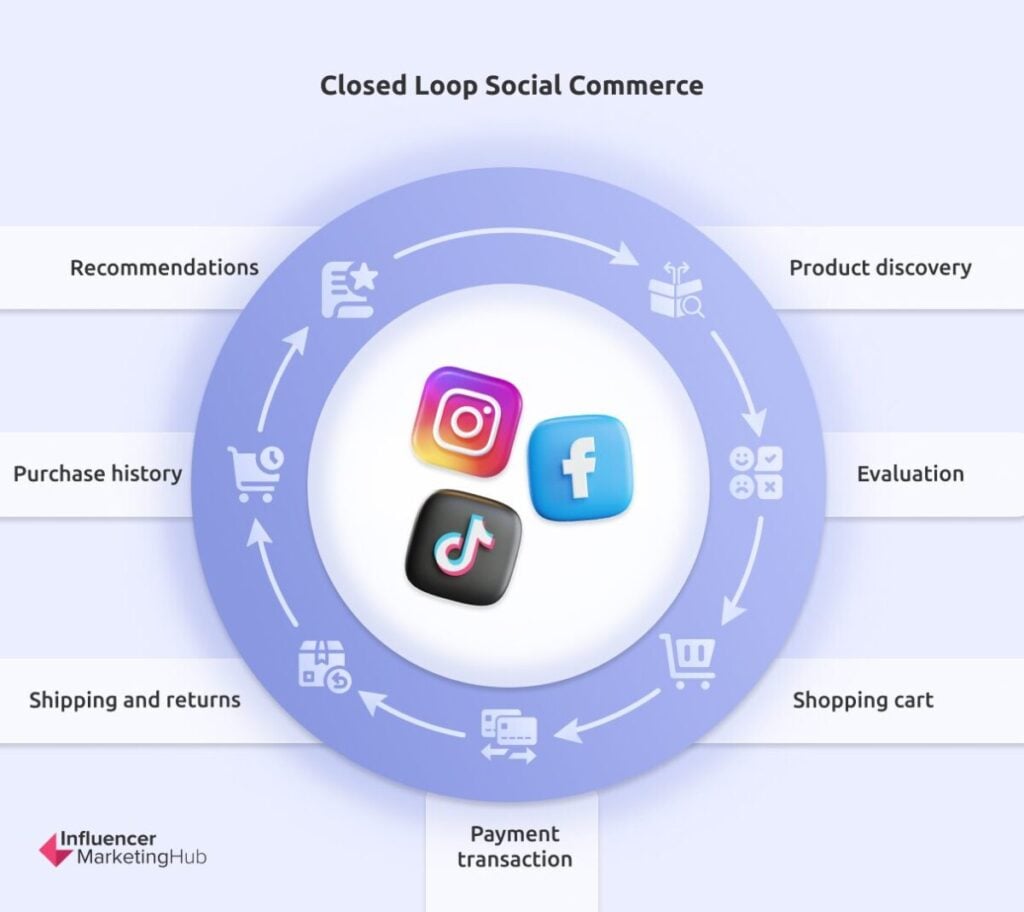

Why Closed-Loop Social Commerce is a Recreation-Changer
Seamless Consumer Expertise: In a closed-loop system, social commerce removes friction from the shopping for journey. Customers can uncover merchandise, consider choices, full transactions, and even deal with returns all throughout the identical platform. This comfort minimizes drop-off charges which have traditionally hindered social commerce by breaking the journey throughout a number of websites.
Elevated Belief and Conversion Charges: We all know that belief and perceived worth considerably influence buy intentions. By retaining transactions throughout the social platform, these closed-loop techniques reinforce belief, as customers really feel they’re participating in a well-known and safe surroundings. Belief components corresponding to model affiliation, reliability of influencers, and clear returns may be instantly managed inside these platforms, driving greater buy charges.
Enhanced Personalization and Concentrating on: Social platforms now have entry to richer client knowledge by managing the end-to-end procuring expertise. This enables them to personalize suggestions based mostly on a consumer’s conduct, preferences, and even previous purchases, instantly enhancing perceived worth, a key driver of social commerce engagement. Platforms can even enhance focused advertisements, growing the relevancy of product suggestions and additional boosting buy intentions.
Influencer Impression on Perceived Worth: Influencer advertising performs a pivotal position within the social commerce ecosystem by including perceived worth to merchandise. As proven within the Lebanon examine, influencers improve perceived worth and belief in a product, particularly when shoppers view them as credible and relatable. By integrating influencers inside a closed-loop social commerce expertise, platforms can instantly join influencer content material with buying actions, making the influencer endorsement-to-purchase journey rather more quick and compelling.
With platforms investing closely in closing the commerce loop and refining their data-driven personalization capabilities, social commerce is primed for widespread adoption in 2025. In contrast to previous makes an attempt that faltered attributable to fragmented consumer journeys and lack of belief, these new ecosystems supply an built-in expertise that builds consumer confidence and streamlines the trail to buy. Social platforms’ means to harness consumer knowledge and personalize suggestions will solely develop, giving them unparalleled benefits over conventional e-commerce websites.
Impression of Influencer Advertising and marketing on Buy Intentions within the UAE
Within the UAE, influencer advertising has emerged as a big driver of client buy intentions, particularly amongst youth who look to social media not just for leisure but additionally for product discovery and steerage on buy selections. An information-driven evaluation reveals that, to successfully affect buying conduct, influencers have to embody particular qualities that resonate with the cultural, psychological, and social expectations of their followers within the area.
1. Credibility and Trustworthiness are Paramount
What the Viewers Expects: Trustworthiness is among the most valued qualities that UAE shoppers search for in an influencer. Youth within the UAE place excessive significance on influencers being perceived as credible and dependable sources of data. Knowledge from a current examine reveals that attributes like trustworthiness, reliability, honesty and approachability in influencers rating persistently excessive (means starting from 3.55 to three.84), indicating that followers usually tend to act on product suggestions from influencers they belief.
How Influencers Can Ship: For influencers, which means any model affiliation should really feel genuine. Influencers ought to prioritize clear communication, particularly with paid partnerships. UAE audiences are extremely perceptive and might sense inauthentic endorsements, which may result in disengagement and lack of credibility. To keep up belief, influencers ought to select manufacturers they genuinely assist, aligning with services or products they’d use personally and advocate to mates.
2. Relatability and Cultural Relevance
What the Viewers Expects: UAE shoppers count on influencers to really feel relatable, culturally attuned, and in contact with native values. An influencer’s means to mirror the viewers’s pursuits and life-style decisions creates a sense of connection and understanding. For instance, the examine signifies that influencers who share relatable content material and exhibit heat and friendliness (imply > 3.7) are perceived extra favorably.
How Influencers Can Ship: Influencers ought to embrace components of UAE’s tradition, corresponding to emphasizing household values, neighborhood spirit, and respect for cultural customs. Content material tailor-made to native experiences—corresponding to relatable Ramadan or Nationwide Day celebrations—deepens emotional connections and fosters viewers loyalty. Relatability can be achieved by discussing on a regular basis experiences, challenges, and successes, making the influencer seem extra accessible and genuine.
3. Offering Informative and Partaking Content material
What the Viewers Expects: Past persona traits, UAE followers search influencers who present substantial details about the merchandise they endorse. The most typical interactions youth have with influencers contain looking for extra info on merchandise (imply of two.07), indicating a want for in-depth product data moderately than surface-level promotion.
How Influencers Can Ship: Influencers ought to prioritize creating academic content material that goes past easy endorsements. As an illustration, opinions that discover product options, reveal utilization, or supply suggestions are valued by followers seeking to make knowledgeable buying selections. Video-based content material, corresponding to tutorials and reside demonstrations, is especially efficient, because it provides a complete take a look at the product, serving to followers assess its high quality and relevance to their wants.
4. Advocating for Social and Moral Causes
What the Viewers Expects: There’s a rising expectation for influencers within the UAE to align with moral and social causes, reflecting broader traits in client conduct throughout the area. In response to current analysis, 63% of influencers within the MENA area elevated their deal with social causes over the previous 12 months, with subjects corresponding to environmental sustainability and social justice gaining traction. This shift is in keeping with the values of youthful generations within the UAE, who prioritize manufacturers and influencers that reveal a dedication to optimistic social influence.
How Influencers Can Ship: Influencers can strengthen their affect by partnering with manufacturers that align with socially accountable initiatives, corresponding to sustainability or neighborhood improvement. By advocating for causes that resonate with the neighborhood, influencers can deepen their emotional bond with followers, fostering a way of shared function. Authenticity is crucial right here; followers ought to see that the influencer is genuinely invested in these causes, not merely utilizing them as a promotional tactic.
5. Sustaining Interactive and Partaking Relationships with Followers
What the Viewers Expects: UAE youth present a robust choice for influencers who actively interact with them, whether or not by means of feedback, reside interactions, or Q&A classes. Analysis signifies that greater ranges of interactivity improve perceived authenticity and foster a way of neighborhood, making influencers extra impactful on buying selections.
How Influencers Can Ship: Profitable influencers within the UAE prioritize participating with their viewers by means of common interplay. Responding to feedback, addressing questions, and sharing follower suggestions reveal that the influencer values their viewers’s opinions, making a extra customized and reliable expertise. Partaking interactions not solely reinforce authenticity but additionally drive greater ranges of follower engagement, in the end translating to stronger affect on buy intentions.
To actually affect buy intentions within the UAE, influencers should be greater than model promoters; they need to embody qualities that resonate deeply with the expectations of their followers. UAE shoppers search trustworthiness, relatability, and a dedication to social causes. In addition they worth influencers who present informative content material and keep real engagement. By aligning with these expectations, influencers can construct loyal, engaged audiences who view them as trusted voices of their buying selections, setting a robust basis for impactful and enduring model partnerships within the area.
Degree 1: Core Belief-Constructing
Attributes: Basis of Affect
Credibility, Trustworthiness, and Honesty
UAE shoppers count on influencers to be dependable and honest, notably in model partnerships. Clear communication is crucial for belief.
Develop clear tips for model partnerships, prioritizing authenticity and private expertise over overt promotion.
Degree 2: Relatability and Cultural
Relevance: Strengthening Connections
Cultural Resonance, Household Values
Influencers ought to embody native tradition and values, with content material that mirrors UAE traditions like Ramadan or Nationwide Day for larger relatability.
Map out a calendar of culturally vital dates and incorporate these into your content material. Interact on family-centered subjects to foster relatability.
Degree 3: Informative and Instructional
Content material: Including Worth Past Promotion
In-Depth Product Information, Tutorials, and Demonstrations
Followers search detailed insights on merchandise past model affiliation, valuing academic content material like video tutorials and reside demos.
Create content material that goes past model messages with real suggestions, product comparisons, and FAQs. Host Q&A classes and reply to suggestions.
Degree 4: Advocacy for Social and Moral
Causes: Constructing Shared Values
Dedication to Social Duty
Youth worth influencers supporting causes like sustainability and social justice, preferring those that reveal real, ongoing dedication.
Choose causes that align with private and neighborhood values. Observe engagement on social cause-related content material to optimize influence.
Degree 5: Interactive Engagement and Group
Constructing: Personalizing Affect for Direct Impression
Lively Interplay, Two-Method Communication
UAE youth favor influencers who interact interactively, viewing constant responses as indicators of authenticity and approachability.
Designate common instances for reside Q&A or suggestions classes. Use polls and interactive options to contain followers instantly, reinforcing a community-driven method.
The Significance of Psychographics in a Market with 200+ Nationalities
Think about a market the place over 200 nationalities converge, bringing with them a kaleidoscope of beliefs, values, aspirations, and behaviors. That is the MENA area, one of the crucial culturally numerous markets on this planet. Whereas conventional demographic segmentation—age, gender, earnings stage—provides some perception, it falls woefully brief in capturing the complexities of this viewers. In such a dynamic surroundings, psychographics—specializing in folks’s attitudes, pursuits, and values—emerges as essentially the most highly effective software for connecting with shoppers on a significant stage.
However right here’s the problem: the shift towards a cookie-less digital surroundings is making psychographic focusing on tougher. With out third-party cookies to trace behavioral knowledge, conventional on-line advertising methods face vital limitations. The instruments that when enabled hyper-personalized campaigns are disappearing, and types are grappling with tips on how to keep precision and resonance of their messaging. That is the place influencer advertising turns into the game-changer.
A Cookie-less World: An Alternative, Not a Setback
As third-party cookies fade, manufacturers are shedding the power to trace consumer conduct throughout web sites and create hyper-targeted advertisements. Retargeting, lookalike audiences, and customized advert campaigns have gotten much less efficient. On this panorama, influencers supply a singular alternative to fill the void. Their genuine, trust-based relationships with their audiences present a direct line to psychographic insights that no algorithm can replicate. Influencers can act as “first-party knowledge engines,” providing manufacturers a strategy to join authentically with numerous viewers segments within the absence of third-party monitoring.
Psychographics: The Heartbeat of Identification-Pushed Advertising and marketing


Psychographics transcend surface-level traits to faucet into the emotional and psychological underpinnings of client conduct. They enchantment to the why behind the acquisition resolution—beliefs, values, aspirations, and goals. In a area as numerous as MENA, the place shoppers determine not simply with their nationality but additionally with their cultural and social values, the sort of focusing on is crucial. For instance:
A Lebanese expatriate in Dubai could also be drawn to campaigns that emphasize nostalgia and custom.
A Gen Z Emirati might prioritize social accountability and sustainability of their buying selections.
A Saudi millennial might gravitate towards campaigns celebrating neighborhood and collective id.
By aligning advertising messages with these psychographic profiles, manufacturers can create connections that aren’t solely impactful but additionally enduring. Nonetheless, reaching this depth of understanding requires greater than knowledge—it requires cultural translators.
Influencers as Cultural Translators
Influencers are uniquely positioned to bridge the hole between manufacturers and numerous viewers segments. They’re extra than simply content material creators; they’re cultural translators who perceive the nuances of their communities in ways in which knowledge alone can not seize. Their storytelling displays shared beliefs, pursuits, and values, making their content material resonate on a deeply emotional stage.
Think about how influencers in MENA might deal with the area’s variety:
Language and Dialect: A bilingual influencer can cater to Arabic-speaking and English-speaking audiences seamlessly, adapting tone and messaging for every group.
Cultural Relevance: An influencer in Saudi Arabia can mirror the significance of household and custom, whereas a life-style influencer within the UAE can emphasize cosmopolitan aspirations.
Social Values: Influencers advocating for social causes—corresponding to sustainability, psychological well being, or gender equality—can align their narratives with Gen Z’s values throughout the area.
By leveraging these cultural nuances, influencers can craft narratives that resonate with psychographic profiles, creating campaigns that really feel private and genuine.
The Shift from Intrinsic to Extrinsic Triggers
One of many key benefits of psychographic focusing on by means of influencers is the return to intrinsic motivators. Early iconic campaigns—like Michael Jordan’s “Be Like Mike” or Dove’s “Actual Magnificence”—didn’t simply promote merchandise; they offered aspirations and values. They engaged audiences on an emotional stage, enjoying to their goals, insecurities, and self-image.
In distinction, many fashionable campaigns prioritize extrinsic motivators—reductions, flash gross sales, and algorithm-driven virality. Whereas these techniques drive short-term conversions, they not often foster lasting emotional connections. Influencers, with their means to attach authentically, can convey again the depth and resonance of identity-driven advertising. They’re the storytellers who can shift the narrative from “purchase this product” to “this product is an extension of who you might be.”
Hyper-Concentrating on By means of Influencers in a Numerous Market
In a market with 200+ nationalities, influencers present the precision wanted to navigate cultural and psychographic variety. Right here’s how:
Localized Narratives: Influencers can create tailor-made content material that displays the cultural nuances of particular nationalities or communities, making campaigns really feel hyper-local.
Area of interest Audiences: Nano and micro-influencers, with their smaller however extremely engaged audiences, can goal area of interest segments which can be usually missed in mass campaigns.
Belief and Authenticity: Influencers’ established relationships with their audiences permit them to ship messages which can be trusted and credible, in contrast to conventional advertisements that usually really feel impersonal.
First-Celebration Insights: By participating instantly with their followers, influencers can collect qualitative insights—preferences, ache factors, and aspirations—that manufacturers can use to refine their methods.
For instance, an influencer marketing campaign selling sustainable style might function a number of tiers of influencers:
A nano-influencer highlighting the affordability of sustainable clothes to budget-conscious audiences.
A micro-influencer advocating for moral practices to eco-conscious millennials.
A mid-tier influencer showcasing trendy designs to fashion-forward Gen Z shoppers.
This multi-tiered method ensures that each section of the viewers is reached with messaging that resonates with their distinctive psychographic profile.
The Function of Expertise in Psychographic Concentrating on
AI and knowledge analytics are enjoying an more and more vital position in influencer advertising, notably in figuring out psychographic patterns. AI-powered instruments can analyze influencer content material, engagement metrics, and viewers demographics to match manufacturers with the best influencers. This precision permits manufacturers to align their campaigns with the values and pursuits of their target market segments.
Nonetheless, whereas expertise can support in figuring out influencers and analyzing efficiency, it can not exchange the human component of storytelling. The best campaigns will at all times be people who mix data-driven insights with genuine narratives crafted by influencers.
The Way forward for Advertising and marketing in a Cookie-less World
As we transfer right into a privacy-first digital panorama, the significance of psychographics in advertising can’t be overstated. Influencers are uniquely positioned to navigate this shift, providing a strategy to join with audiences on a deeper, extra significant stage. For manufacturers in MENA, the place variety is each a problem and a possibility, influencer advertising is not only an choice—it’s a necessity. By embracing psychographics and leveraging influencers as cultural translators, manufacturers can create campaigns that resonate throughout the area’s wealthy tapestry of identities, values, and aspirations.
In a market the place over 200 nationalities converge, the query isn’t whether or not influencer advertising will thrive—it’s whether or not manufacturers are able to embrace its full potential.
Way forward for Influencer Advertising and marketing in MENA
MENA doesn’t lack expertise, creativity, or client urge for food—it lacks activation. The chance is huge: a youngy market with rising client spending energy, a authorities dedicated to fostering digital innovation, and a inhabitants more and more aligned with international values of belief, authenticity, and social accountability. However to grab this chance, manufacturers, companies, and influencers should rethink the basics. The way forward for influencer advertising in MENA isn’t about doing extra of the identical; it’s about daring to guide the cost towards authenticity, moral practices, and psychographic precision.
This report is each a roadmap and a name to motion. The time for incremental progress is over. The manufacturers and influencers who rise to this problem—who embrace nano-influencers, prioritize long-term methods, and lead with moral transparency—won’t simply reach MENA; they’ll set the usual for influencer advertising worldwide. The query isn’t if MENA can redefine the principles of engagement however who could have the imaginative and prescient and braveness to guide this transformation. The stage is about, the viewers is prepared—now’s the time to behave.
The MENA area, with its unmatched cultural variety, digital enthusiasm, and youth-driven client base, stands on the threshold of transformative progress in influencer advertising. But, as our deep-dive evaluation reveals, the present ecosystem is fraught with strategic gaps that manufacturers and influencers should deal with to unlock this potential. These gaps are usually not merely operational inefficiencies; they symbolize misplaced alternatives in a area poised to outline the way forward for influencer advertising on a worldwide scale.
On the coronary heart of MENA’s challenges lies a paradox. Whereas international manufacturers shift towards authenticity, hyper-local engagement, and psychographic-driven methods, many MENA manufacturers stay anchored in outdated paradigms—over-reliance on mega-influencers, short-term campaigns, and single-platform methods. The result’s a market ripe with expertise, innovation, and viewers urge for food, however restricted by its lack of ability to activate this potential holistically.
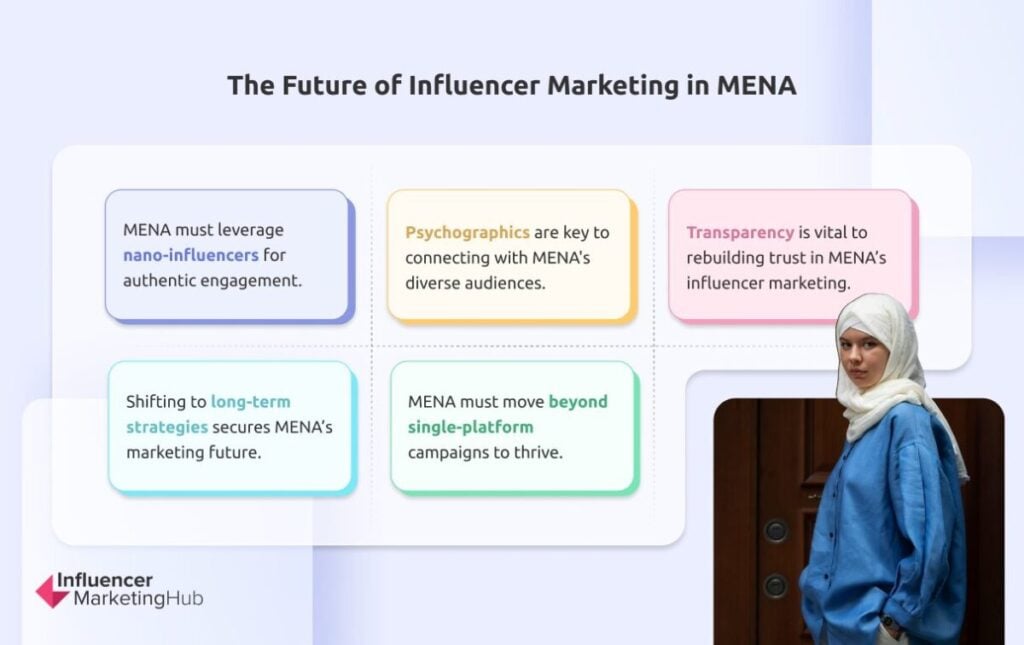

The Missed Potential of Nano-Influencers
Globally, nano- and micro-influencers are revolutionizing client engagement by means of authenticity and belief, driving unprecedented ranges of viewers connection. In distinction, MENA continues to lean closely on macro- and mega-influencers, leaving over 13.2 million nano-influencers underutilized. This misalignment not solely stifles grassroots-level engagement but additionally alienates audiences who more and more worth relatability over attain. Manufacturers in MENA should acknowledge that the longer term lies in a tiered influencer ecosystem that balances authenticity, scalability, and ROI. The query is now not whether or not nano-influencers matter—it’s how shortly MENA can recalibrate to include their potential.
Psychographics: The Lacking Ingredient
In a market outlined by over 200 nationalities (MENA total above 800), psychographics should be the cornerstone of each marketing campaign. Demographics alone can now not seize the wealthy tapestry of beliefs, aspirations, and behaviors that drive client selections in MENA. With the appearance of a cookie-less digital world, conventional data-driven methods are shedding their edge. Influencers, performing as cultural translators, maintain the important thing to navigating this shift, providing manufacturers unparalleled entry to first-party psychographic insights. The power to faucet into what really strikes an viewers—whether or not it’s social accountability, cultural alignment, or shared values—will separate the market leaders from the laggards.
Moral Duty: The Belief Deficit
Transparency in influencer advertising is now not optionally available; it’s important. But, over 40% of MENA influencers report stress from manufacturers to sidestep disclosure laws, making a credibility disaster. Customers in MENA, notably Gen Z, demand authenticity and moral alignment from each manufacturers and influencers. With out structured oversight and a dedication to moral practices, the area dangers eroding the belief that’s the basis of influencer advertising. The longer term belongs to those that acknowledge that transparency isn’t a constraint however a possibility to construct deeper, extra significant connections.
Quick-Termism: The Barrier to Sustainable Impression
The overemphasis on one-off campaigns and top-of-funnel metrics undermines the long-term potential of influencer advertising in MENA. Over 60% of manufacturers within the area depend on short-term collaborations, lacking the sustained advocacy and belief that solely long-term partnerships can present. By shifting towards sustained collaborations, manufacturers can’t solely amplify their message but additionally foster the form of loyalty that drives lifetime client worth. The problem is evident: manufacturers should evolve from short-term visibility to full-funnel methods that interact audiences at each stage of the client journey.
Multi-Platform Methods: The Roadmap to Engagement
In a area dominated by TikTok’s 11.3 million nano-influencers and Instagram’s higher-tier dominance, MENA manufacturers proceed to rely closely on single-platform campaigns. This fragmented method fails to seize the multi-channel behaviors of right this moment’s digitally native shoppers. A strategic, full-funnel, multi-platform method—one which leverages TikTok for consciousness, Instagram for aspiration, and YouTube for training—can unlock the area’s untapped potential. The combination of AI-driven analytics and platform-specific methods would be the differentiator for manufacturers seeking to maximize their affect.



